
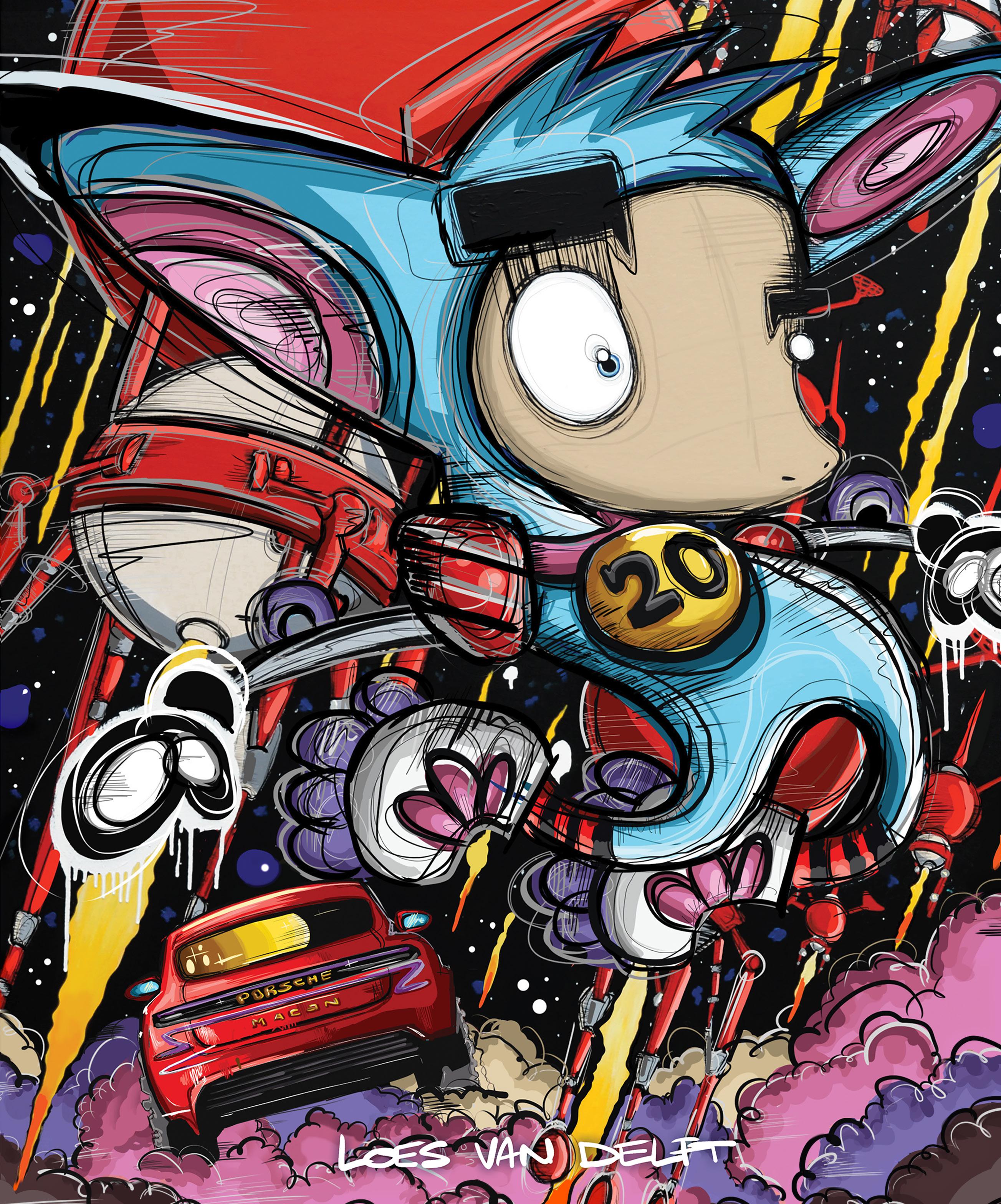
Magazine for Porsche enthusiasts • year 20 • quarterly • February / March 2024 • 77
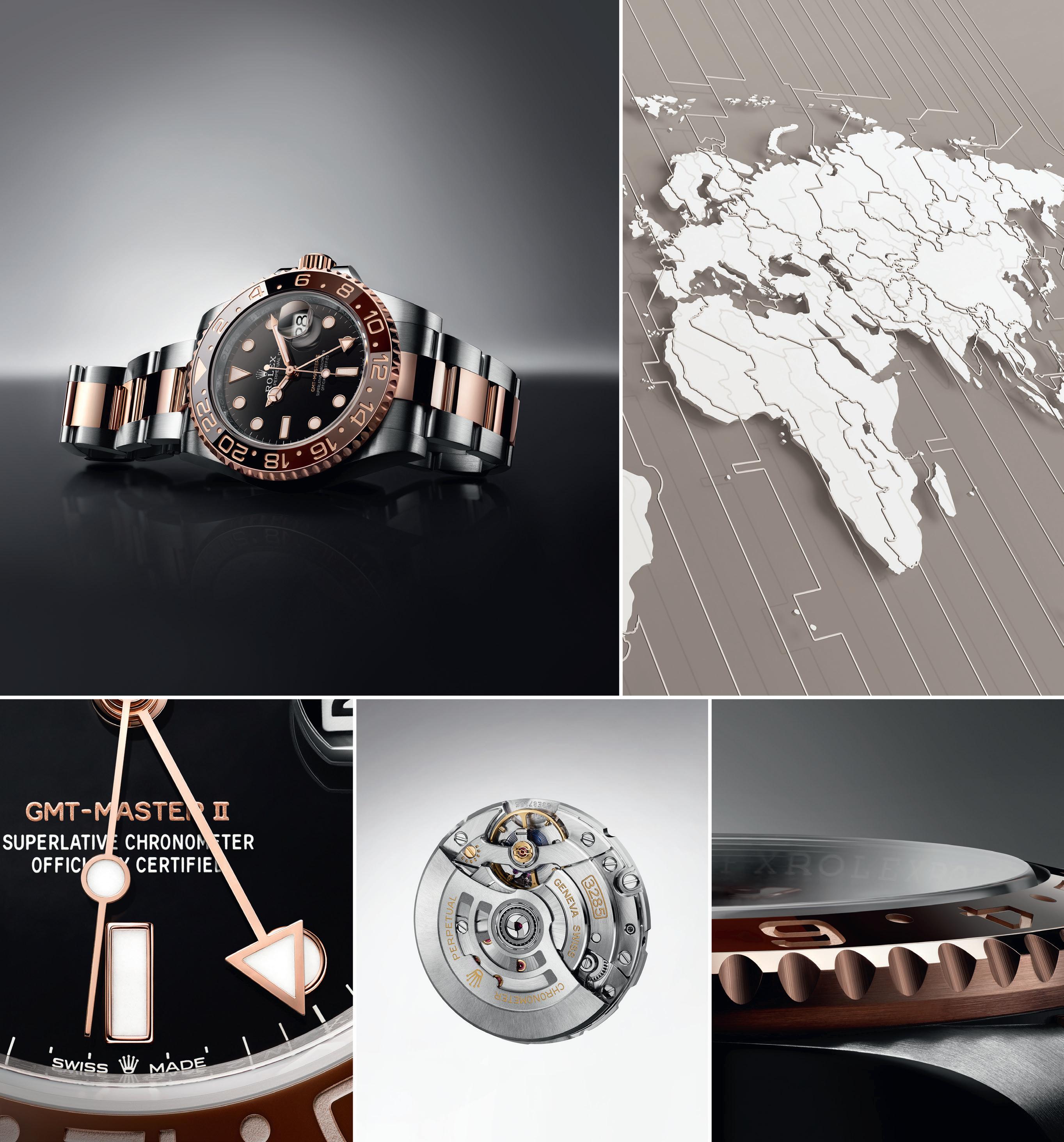



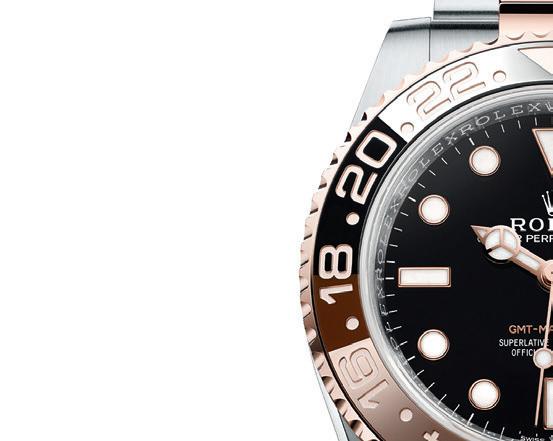
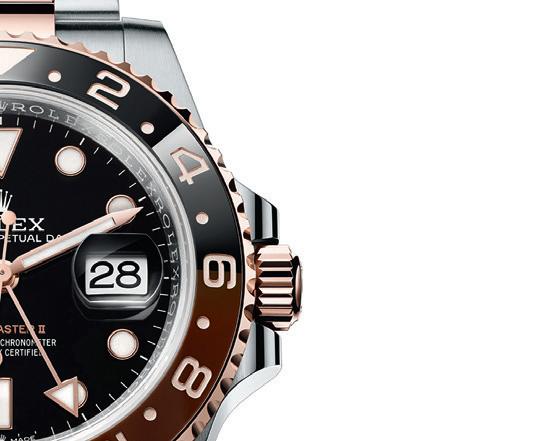
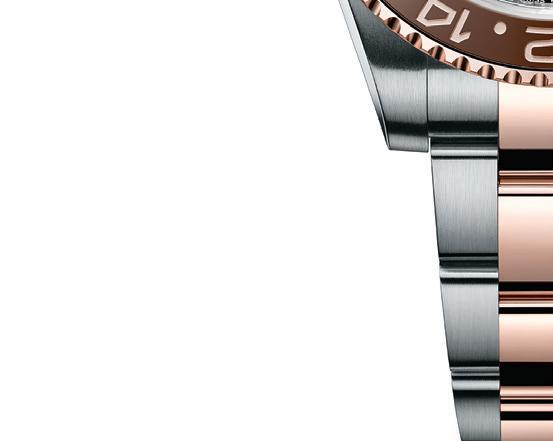
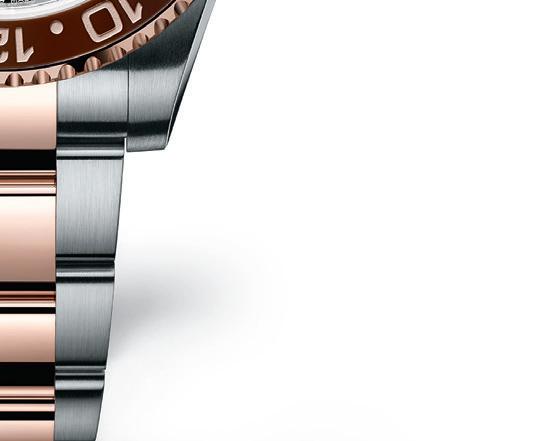




What better way to soak up the sun than taking family and friends on a delicious drink journey around the globe? With Fever-Tree you can discover crisp flavours of Mexican bitter oranges, refresh your palate with lemon thyme and rosemary harvested at the shores of the Mediterranean Sea and savour the botanical aromas of African quinine. The particularly fine carbonation of our mixers pairs with premium spirits for an exquisite drink experience that’s meant to be shared.
COCHIN WARM & SPICY GINGER SICILY LEMON I V O R Y COA S T FR E SH GR E E N GI N G E R ALICANTE PINK GRAPEFRUIT CONGO QUININE NIGERIA EARTHY GINGER ENGLAND ELDERFLOWER SPAIN ROSEMARY PROVENCE LEMON THYME MEXICO BITTER ORANGE STRATHMORE VALLEY, SCOTLAND RASPBERRIES
IS
NATURALLY SOURCED INGREDIENTS FROM ALL OVER THE WORLD
MIX WITH THE BEST IF OF YOUR DRINK mixer ,
THE

ZAMBIA
The untamed heart of Africa
Text: Kathleen Van Bremdt - Photos: Sven Hoyaux
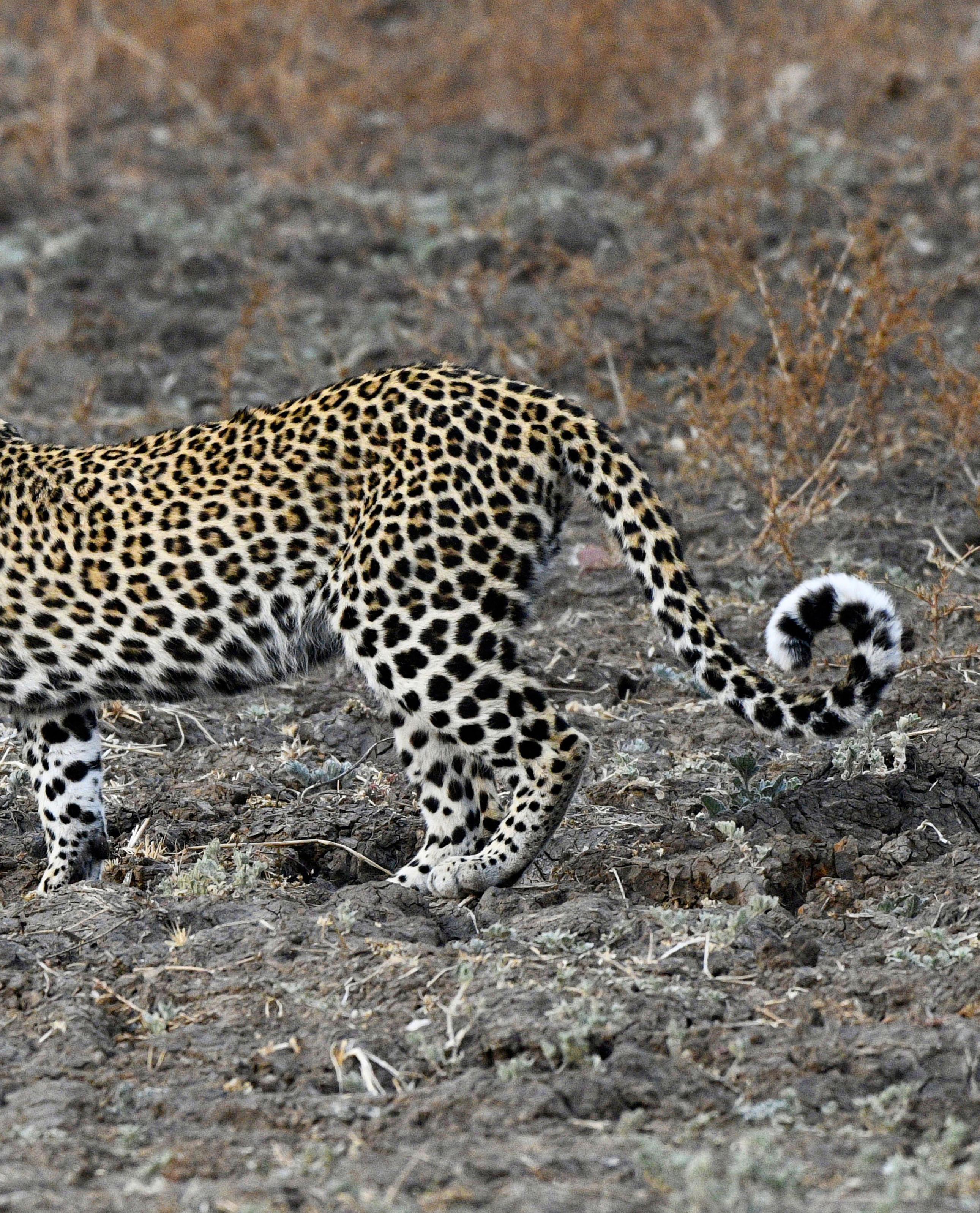
PORSCHIST TRAVEL

e read on a website: If you choose a tour around Zambia, you have probably already been on safari several times in other countries and are looking for a destination off the beaten track. That's right. We want to discover something new. According to experts, Zambia is still the real Africa with vast savannahs where wildlife roams freely and a hospitable population that has not yet lost its connection with nature.
TRAVEL PORSCHIST
Oscar Chavula with his handsome 992 in front of the parliament building in Lusaka.

When we arrive at the international airport after a journey of 13 hours, we are in a hurry. We have an interview with the Minister of Tourism Rodney Sikumba that same afternoon and can't afford to waste any time. Of course, things happen at such moments that throw a spanner in the works. In our case, it is the baggage carousel that breaks down. All luggage has to be transferred by hand to another belt and that is painfully slow. The delay makes us nervous. It's already 1:30 PM and the interview is at 4 PM. A quick calculation shows that it will be quite tight: a half-hour drive to the hotel, some fifteen minutes to freshen up and a forty-five minute drive to parliament. Fortunately, despite everything, we manage to arrive at the appointed place on time. We could have saved ourselves the stress, because it takes another two hours before the minister has time to meet us. But then we do have the man to ourselves. Rodney Sikumba is extremely cordial and willingly answers all the questions we fire at him. Nothing ventured, nothing gained, so we are so bold as to ask the man if it might be possible to take pictures of a Porsche in front of the parliament building. We don't expect it to happen in any other country, but the man really doesn't mind. He promises to inform his clerk and his PR manager and we are expected the next day at ten o’clock.
Now we just have to hope that the Porsche owner also has time, because he doesn't know about this yet. We meet Oscar Chavula that same evening and yes, he can make himself available for a photo session at parliament. By the way, he knows the minister personally. The saying 'everyone knows everyone' also applies here and of course, as an important businessman, he is on friendly terms with the minister.
FOTOSHOOT NATIONAL ASSEMBLY OF ZAMBIA
The photo shoot happens in African style: with a lot of fuss and wasted time. We easily pass the checkpoint at the entrance to the domain, but once we are standing at the top of the steps in front of the parliament building with our cameras, the problems start. The minister had assured us that his press attaché would take the necessary measures to ensure the photo shoot went smoothly, but apparently internal communication did not go quite as well as we hoped. People with various positions suddenly become involved and want to give their input. The security man in particular wants to make us feel that he is in charge. 'I have to know everything' he tells us while he expands his chest a little more than it already is. We feel like we need to let this man put on his show. He starts calling people to whom he makes long speeches while gesticulating wildly. He casually points out that we are not dressed appropriately. Casual clothing is not permitted within the assembly grounds. We explain that we were dressed to the nines the day before for the interview with the minister, but that we are now in work clothes for the photo shoot. He seems to understand that. In the meantime, more and more people are arriving. Most just out of curiosity, others to give their colleagues the impression that they are involved in the matter even though that is not the case. Only after Oscar Chavula arrives in his bright yellow Porsche 911 does everything suddenly go smoothly. Whether it is his presence or that of the Targa that makes things easier, we're not sure. We take photos with the words 'National Assembly of Zambia' in the background, exactly what we wanted.
9
TRAVEL PORSCHIST
WHERE IS ZAMBIA?
Zambia is located in southern Central Africa, bordered by eight countries including - clockwise - Tanzania to the northeast, Malawi to the east, Mozambique to the southeast, Zimbabwe to the south, Botswana and Namibia to the southwest, Angola to the west and the Democratic Republic of Congo in the north. The mighty Zambezi River is one of the country's most important waterways and forms the natural border with Zimbabwe. Zambia was a British colony for a long time and was called Northern Rhodesia until it became independent in 1964. Although completely landlocked, Zambia has no shortage of water thanks to the many rivers of which the three largest – the Zambezi, the Kafue and the Luangwa – determine the geography and the rhythm of life. Even though the country is not really known as a safari destination, Zambia certainly is.

WILDLIFE DELUXE
No less than 30% of Zambia is still pure nature, which is more than 200,000 km², or 6.5 times the whole of Belgium! Zambia has an enchanting wilderness with an astonishing diversity of wildlife. The government has not yet succeeded in really putting Zambia on the map as a tourist destination, but has long been aware of the importance of nature conservation, which translates into no fewer than 20 national parks and 34 wildlife management areas. In these unfenced reserves, both large and small animals live in complete freedom according to the laws of nature. During a two-week trip it is obviously not possible to cross the entire country, so we choose two parks from the top five to visit: the Lower Zambezi National Park in the east and the South Luangwa National Park in the north of Zambia.
THE LOWER ZAMBEZI NATIONAL PARK: AN OASIS OF BIODIVERSITY
Lower Zambezi is one of the newest national parks in eastern Zambia. In 1983, the Zambezi Valley was declared a national park. Prior to this, the area served as a private game park of the President of Zambia. As a result, the large reserve has been protected from external influences such as poaching, hunting and tourism for a long time. It is therefore not surprising that this is one of the most pristine game parks in all of Africa. Geographically, Lower Zambezi is the most beautiful park in Zambia. The gigantic valley through which the mighty Zambezi River flows like a blue-green lifeline is a true oasis for Zambian wildlife. Because the park is so rich in water, it attracts many water birds and there is a great diversity of wildlife on land.
10






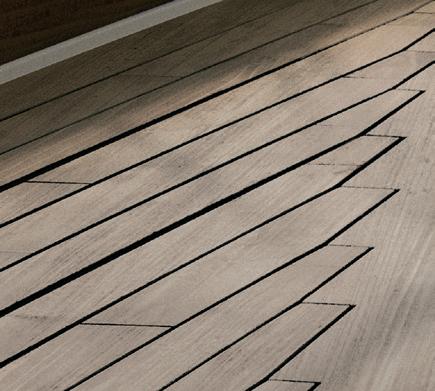

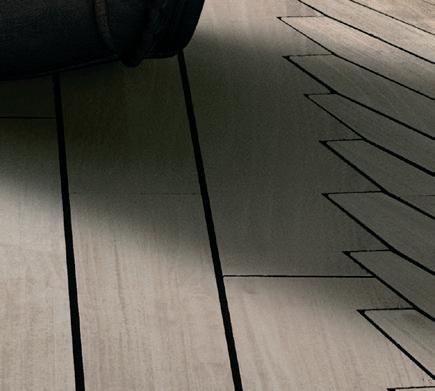

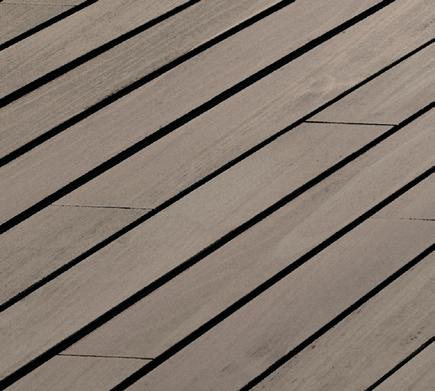



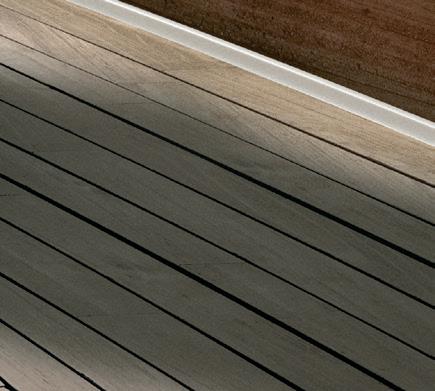



BOURBON-SLEECKX SCHILDE | Turnhoutsebaan 217-221, 2970 Schilde BBQ ATELIER BRASSCHAAT | Bredabaan 948A, 2930 Brasschaat info@bourbon-sleeckx.com | 03 383 06 69 BUITENPROJECTEN A-Z | BUITENMEUBILAIR | LAMELLENDAKEN | TERRASVERWARMING | SCHADUWMAKERS | BUITENKEUKENS | ZWEMBADPRODUCTEN | V ERLICHTING | BARBECUES | DECORATIE OPEN DAYS* zaterdag 2 maart t.e.m. zondag 15 maart 2024 bourbon-sleeckx.com Sinds 1955 BOURBON - SLEECKX * in Schilde - Open Days BBQ Atelier Brasschaat 16 & 17 maart 2024

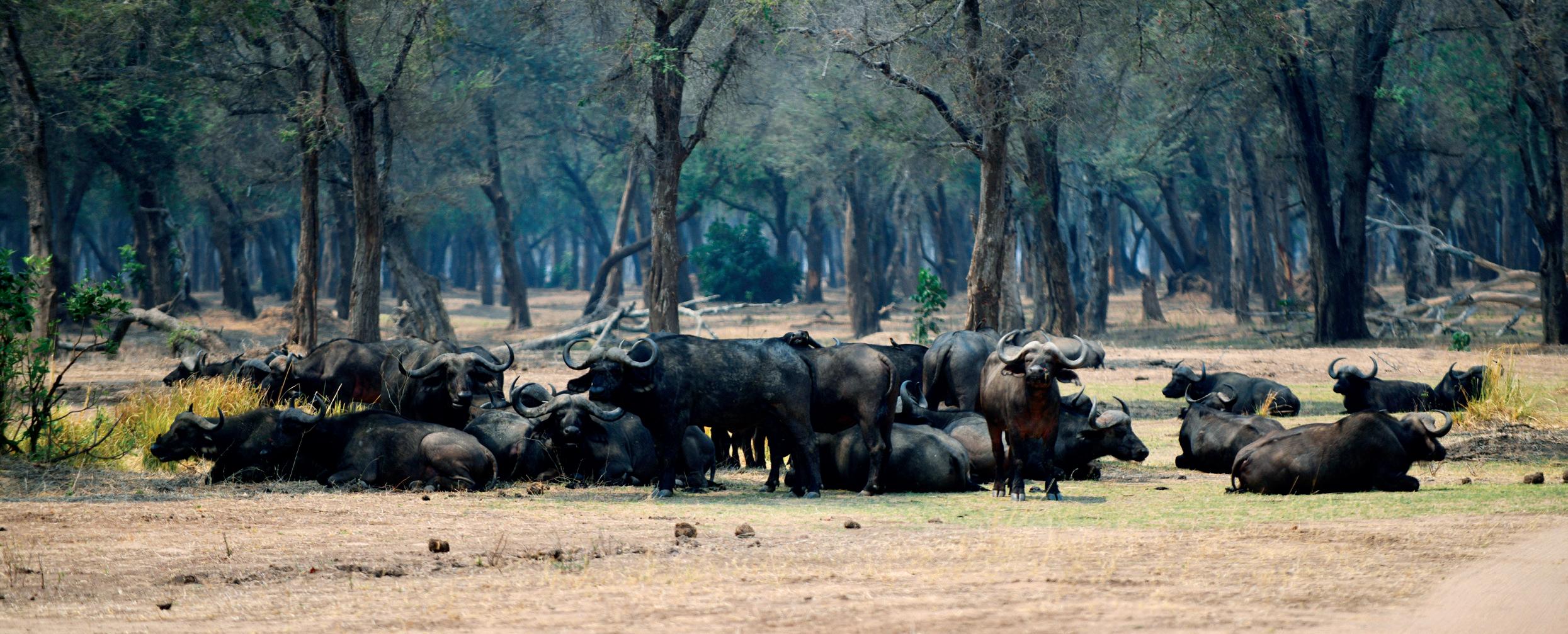
FIRST GAME DRIVE
A small plane that seats 12 people takes us to Jeki in around half an hour. Jeki is nothing more than a strategically located airstrip in the middle of nowhere from which visitors have easy access to several national parks. From Jeki, it is still an hour's drive to our tented camp in the Lower Zambezi National Park. What immediately strikes us is the enormous number of animals. Usually it takes a while before you see any animals and you see them one by one, but here it seems as if they were all waiting for us! Elephants, impalas, kudus, gazelles, buffalos... they all make an appearance. We don't know where to look first. It's almost somewhat surreal, but this is the experience every safari lover is looking for.
Nowhere do we see so many wild animals as here in this still unknown safari country.
TRAVEL PORSCHIST
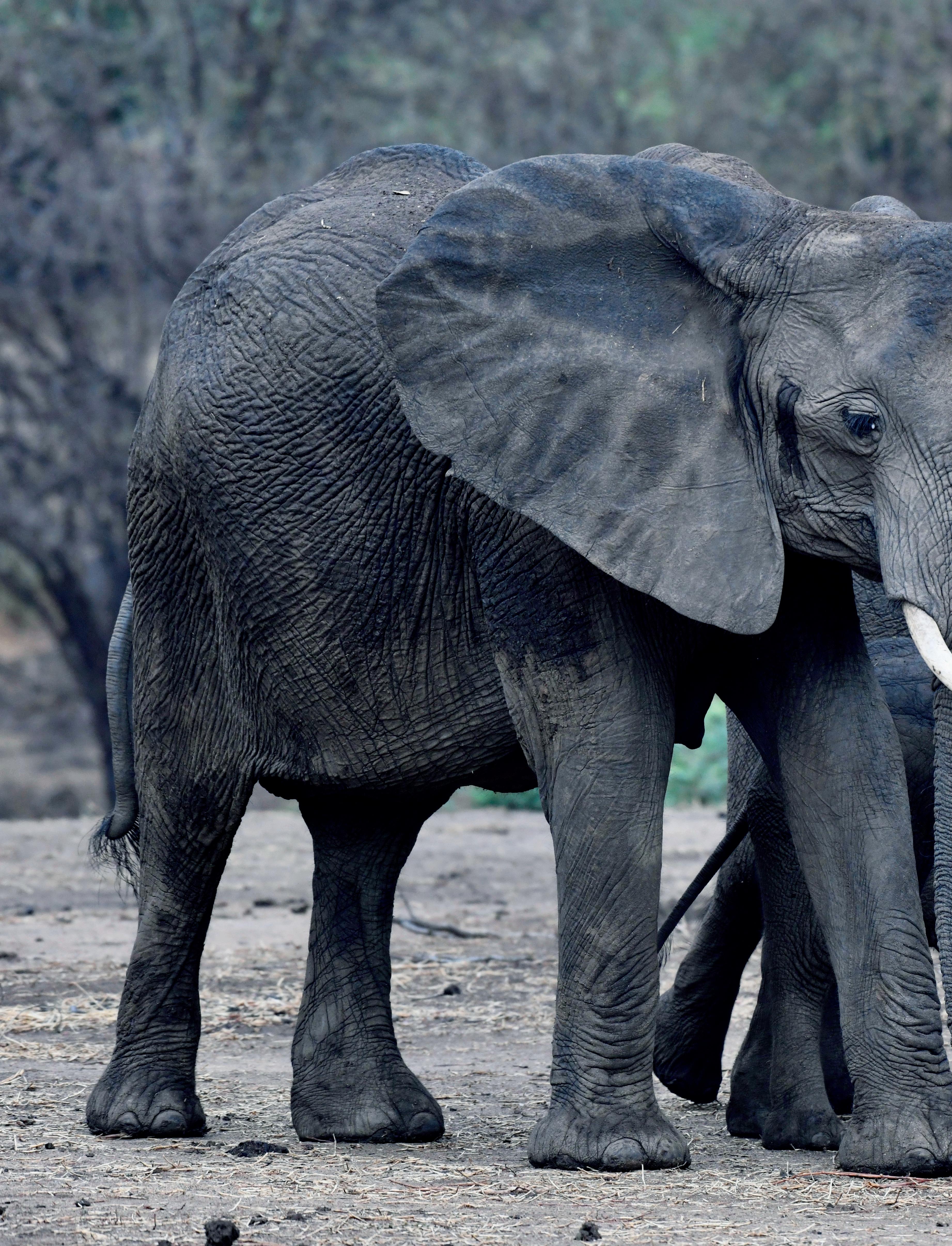
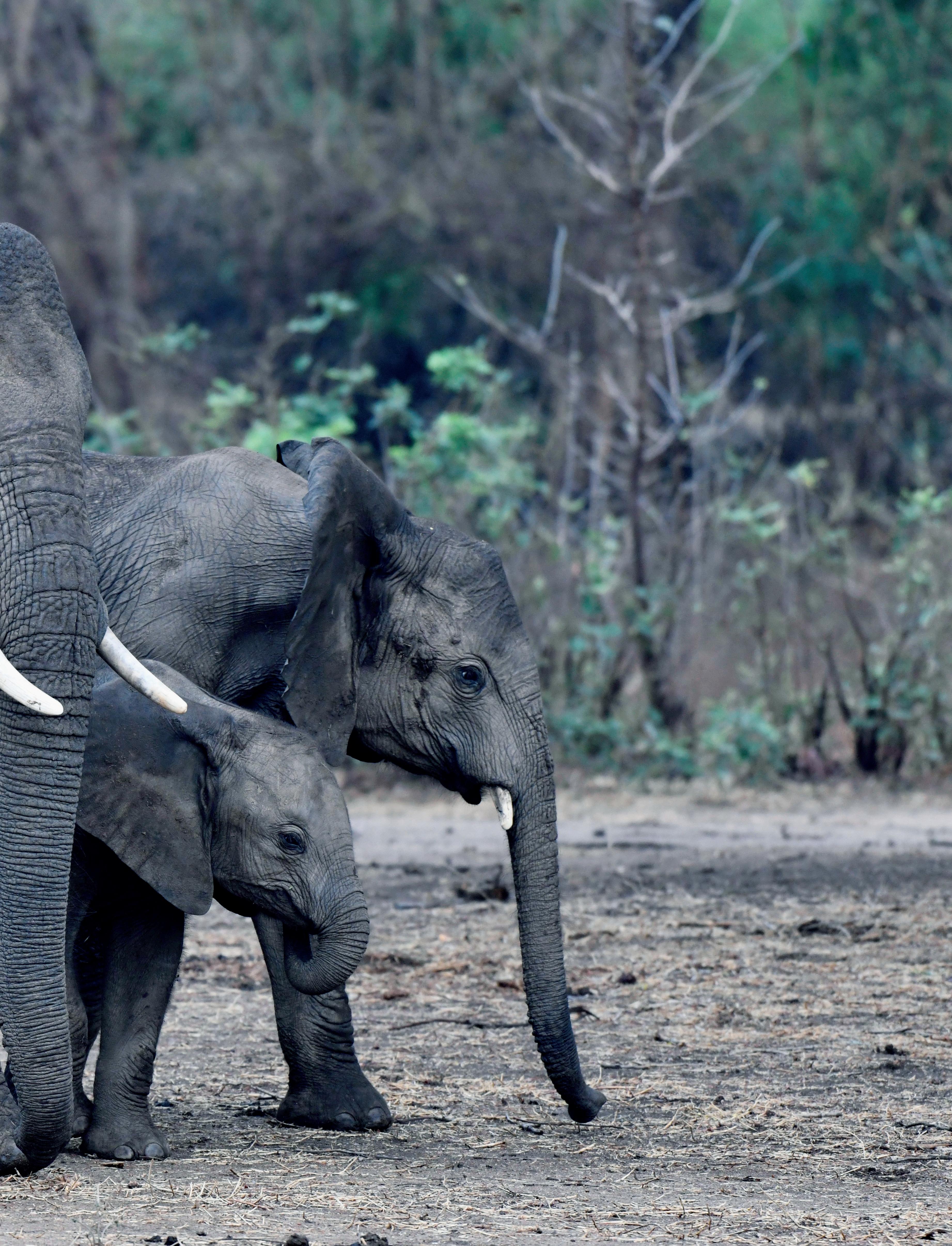
KUTALI CAMP: AN AUTHENTIC BUSH EXPERIENCE
The Kutali camp is built under a canopy of acacia trees on the banks of the Zambezi River. The river is swarming with hippos. Crocodiles are sunbathing on the sandbanks. The view is spectacular. The camp can accommodate just ten guests who, according to the owners' philosophy, are 'completely immersed in nature'. The five tents are simple, with a small open-air bathroom fenced off by deadwood. There is a bucket of water with which we can wash ourselves and a bottle of drinkable water for brushing our teeth. The shower is a 'bucket shower': a canvas bag to which a shower head is attached. Even though the bathroom is primitive, there is a flushing toilet. There is no electricity and no internet in the camp. We're particularly shocked by the latter, because we had not been told that in advance. It is striking where our priorities lie. We talk to Donna, the camp manager, about it. “It is a very conscious choice,” she says. “There are few places on earth where people can still really disconnect. No WiFi is initially a huge adjustment for many guests, but after a few days it is a complete relief. There are quite a few guests who leave here with new insights because they, once freed from all modern means of communication, suddenly found the peace to examine their lives. We want people to experience the real safari spirit in this camp.” We are curious what this digital detox will do to us.
The Kutali camp on the banks of the Zambezi River can accommodate just ten guests who, according to the owners' philosophy, are 'completely immersed in nature'.

16
TRAVEL PORSCHIST
 Kutali Camp, Lower Zambezi National Park.
Kutali Camp, Lower Zambezi National Park.
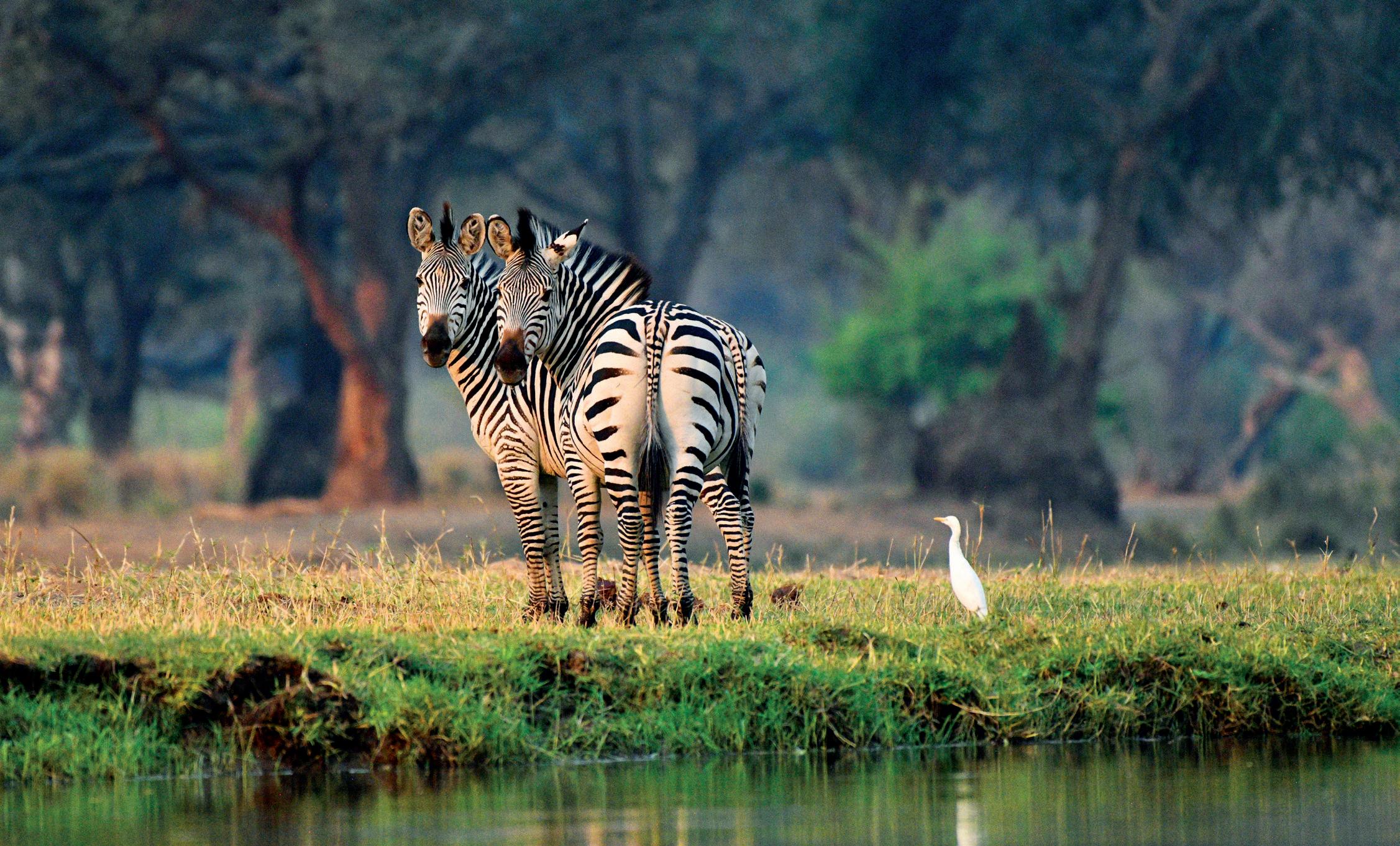
It is very uncomfortable in the camp during the siesta hour. It is October, the warmest month in Zambia, and we're feeling it! The thermometer shows 46 degrees and there isn't a breath of wind. We don't feel well at all. Donna immediately intervenes. “Next to the tank with drinking water are packets of ORS, oral rehydration salts” , she says. "Dissolve the powder in some water and drink it. By sweating you lose a lot of salts that the body itself cannot replenish.” The stuff works wonders and after just fifteen minutes we are again in top shape and ready to start the afternoon game drive. Impalas gambol around and warthogs root around in the earth looking for a tasty snack. The zebras are as beautiful as ever with their black and white striped coats and sturdy manes. In a tree, we spot a leopard. He lies stretched out on a thick branch like an oversized, lazy cat. Saliva drips from his mouth. What a beautiful animal. It doesn't bother him that our camera clicks incessantly and he even looks straight into the lens for a moment. Hypnotic green eyes.
Day and night are two completely different worlds in the bush. The predators prepare for the hunt and the prey devise strategies to survive the night.
18
TRAVEL PORSCHIST
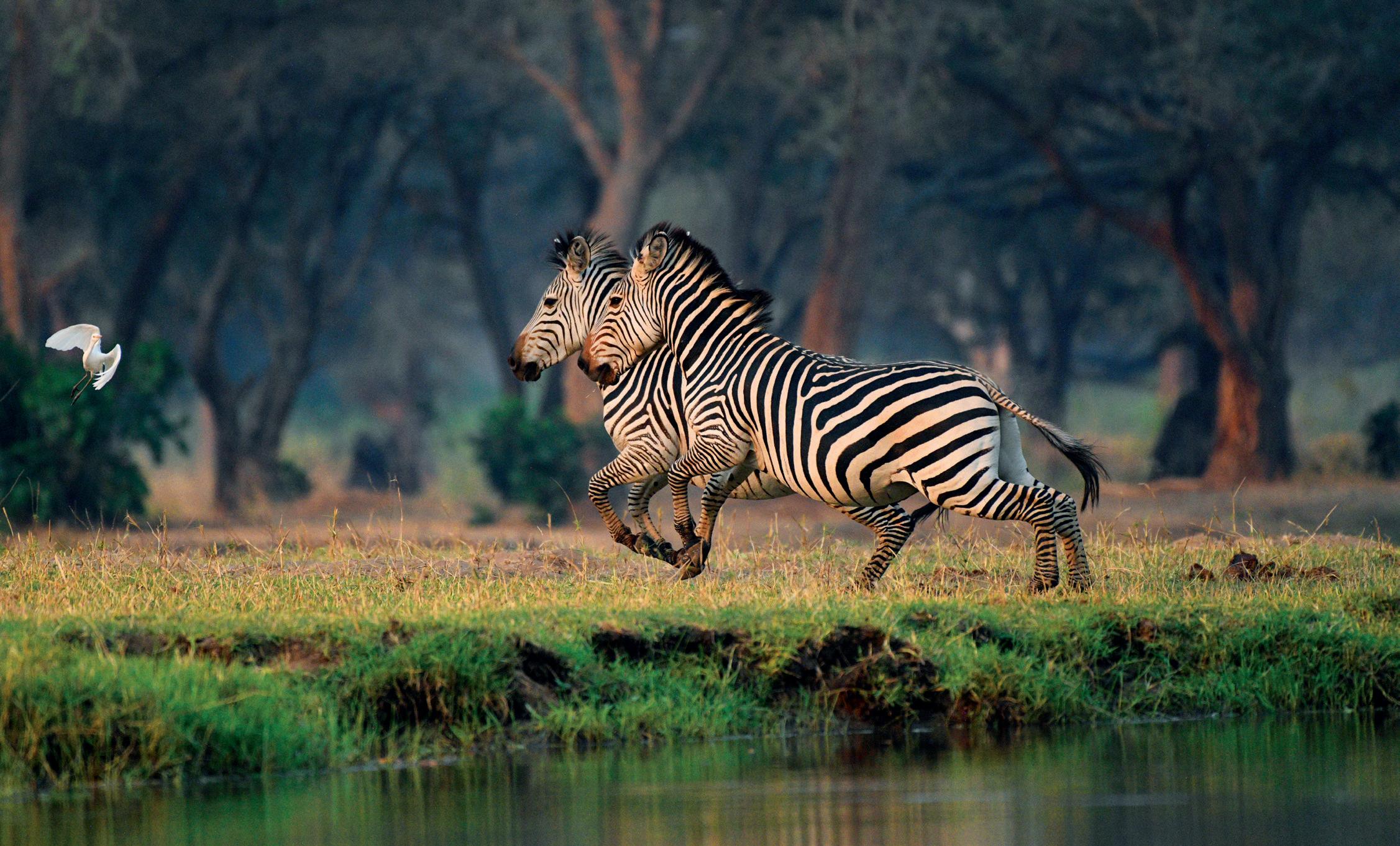
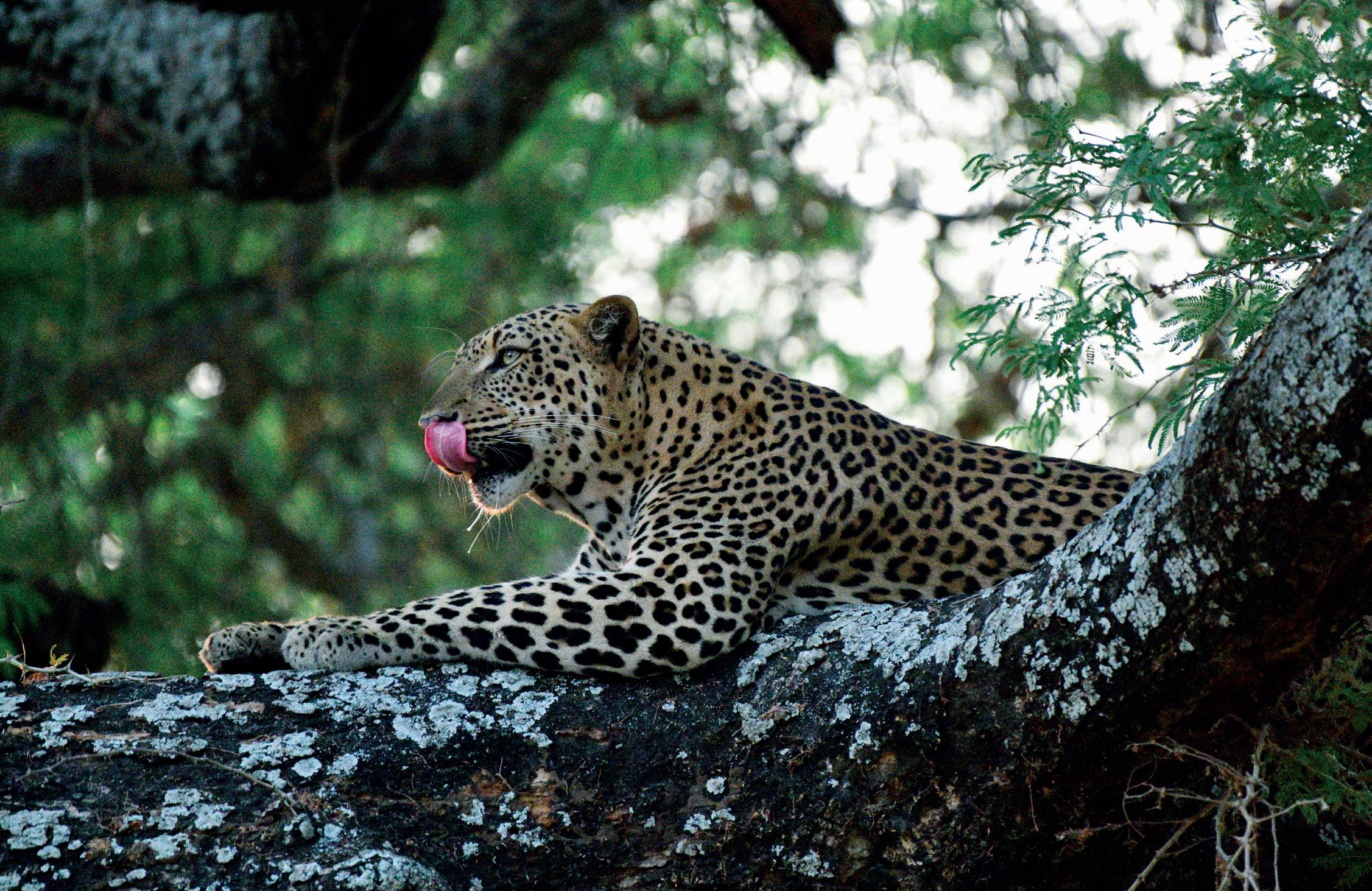
19

DAY AND NIGHT
Time for a sundowner . And we follow the local custom by having a Gin & Tonic. “That custom dates back to British times,” says our ranger Dispenser. “The British also liked to go on safari, looking for the thrill of coming face to face with the rulers of the bush. Tonic was drunk a lot at that time because it is rich in quinine, an effective remedy against malaria. But they found tonic alone quite boring, so they added a generous shot of gin.” With the traditional safari drink in hand, we watch the sun slowly fade away like a bright red ball. As soon as the daylight disappears, the atmosphere changes. Day and night are two completely different worlds in the bush. The predators prepare for the hunt and the prey devise strategies to survive the night. There is tension and mystery in the air. There are also many more sounds. Without light, the animals communicate with sounds. Baboons screech to warn each other when they notice something, hyenas howl to signal their presence and the crickets start their nightly concert. With a large spotlight on the jeep we return to our camp and spot animals along the way that shy away from daylight: a honey badger, a civet cat and a scrub hare.
TRAVEL PORSCHIST









NIEUWE LOCATIE LEYSSTRAAT 1, 2000 ANTWERPEN - 03/213 50 80 SCHUTTERSHOFSTRAAT 30, 2000 ANTWERPEN - 03/226 41 44 WWW.SLAETS.EU
Handgemaakte ring in 18kt witgoud met een unieke Tanzaniet van uitzonderlijke kwaliteit en natuurlijke diamanten. Ieder stuk uit de SLAETS Atelier collectie is uniek en wordt artisanaal vervaardigd in Antwerpen.
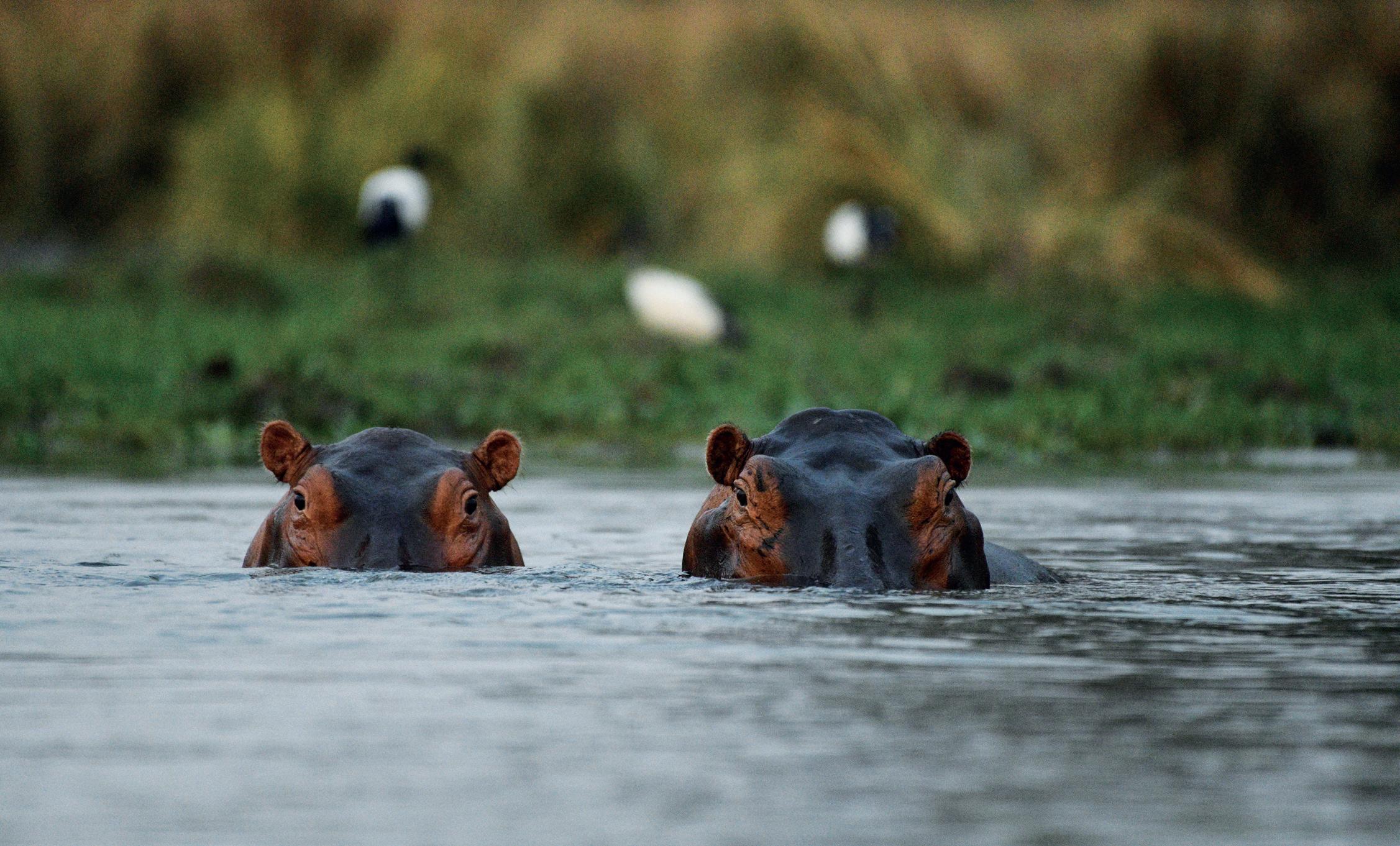

22
TRAVEL PORSCHIST
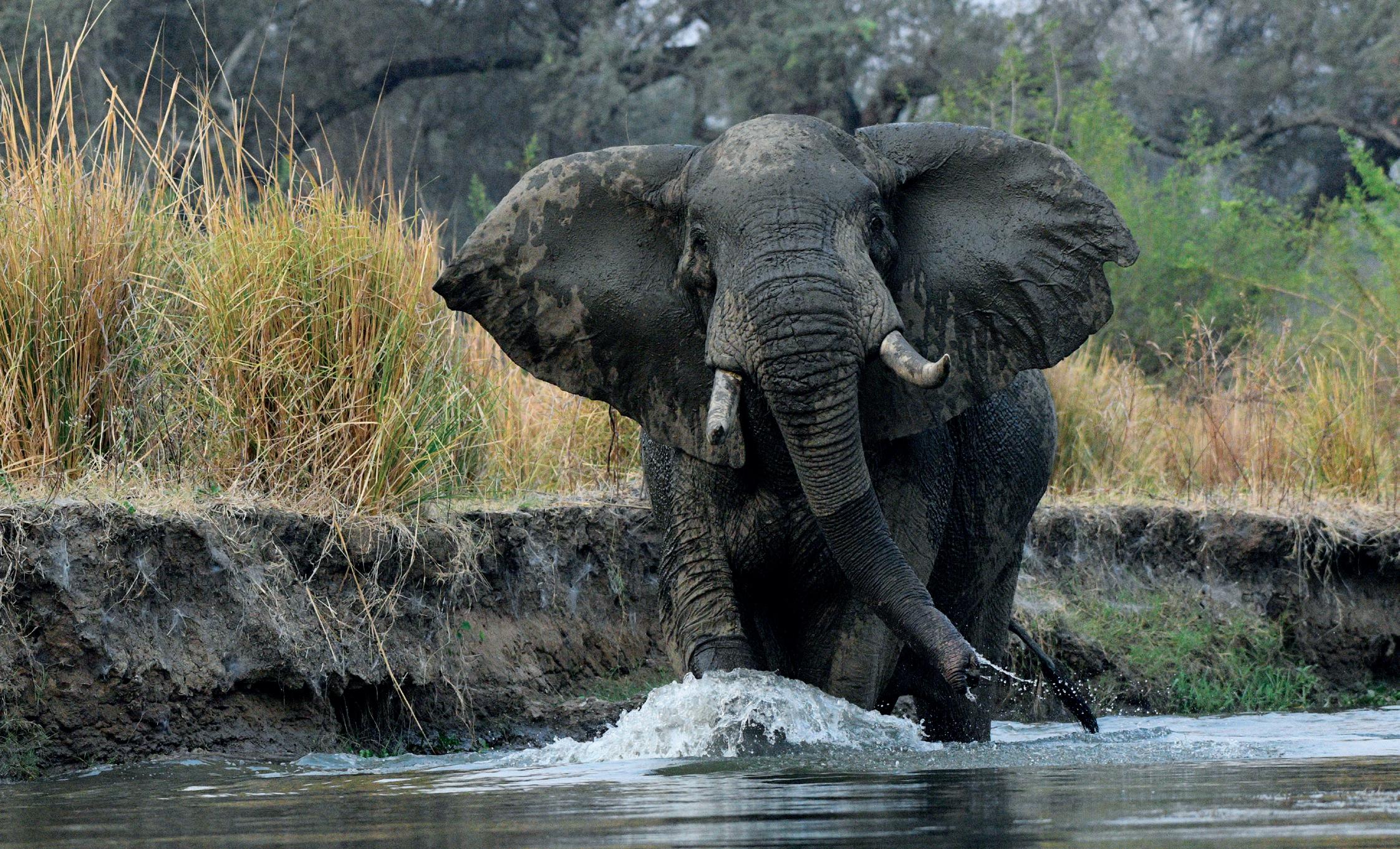
NIGHTTIME VISIT
During the night, we are woken by shuffling near our tent. We can see the outline of an immense hippopotamus. Hippos are just about the moodiest animals in the animal kingdom. During the day they are happy to dobber in the cool river, but when it is dark they come ashore to graze. If your tent is 20 metres from the shore, it is not surprising that their first stop for a meal is right there. We hear the animal snorting and smacking, but it does not seem to be aware of our presence. This is because with tents it works just like with jeeps. The shape is not natural and therefore animals do not see a living being in it. Animals run through a checklist, as it were, when something crosses their path:
1. Can we eat it?
2. Can it eat us?
3. Can we mate with it?
If the answer to all three questions is 'no', then what is in front of them is not interesting at all. But if we were to think about stepping out of the tent now, the story would immediately take a completely different turn. Hence the permanent advice of every camp employee: 'Never leave your tent when there are animals nearby!’
CANOE SAFARI: FACE TO FACE WITH WILDLIFE
The many tributaries of the Zambezi that wind through the savannah are ideal for a canoe safari. Adam is our guide and steers the canoe. We glide almost silently through the water. Apart from some animal sounds, there is complete peace and quiet. It is a completely different experience to observe nature and wildlife in this way. The animals continue with their activities and because we are so low down, we see them from a completely different perspective. The big ones like zebras and elephants seem even bigger than usual. We carefully make eye contact with a drinking buffalo. From the water, it is also much easier to see the many beautiful birds that live here. An osprey rests on the shore and scans the area. The slender silhouette of a snow-white heron is reflected beautifully in the water. Behind a bend, an elephant stands motionless in the middle of the river. Adam reverses the canoe a little. “We have to give the animal space,” he explains. “If we get too close, we'll make it nervous. Now we are giving it options and the elephant can step out of the water in different places.” He has hardly finished speaking
23
before the colossus climbs onto the sandy bank and disappears between the trees. It is incredible how well Adam can interpret animal behaviour. He deals with the hippos in the same way, and there are quite a few on this route. Always wait and see what the animal is planning to do and act accordingly. When a group of about twenty hippos completely blocks the river, we are worried for a moment. We'll never get past this, will we? But Adam remains cool as a cucumber. He points out a hippo in the middle of the group. “Look, that's the leader. He's going to decide what will happen. First, he will check how deep the water is by feeling the bottom with his nose. When he feels that he is on firm ground and sees that we are not planning any harm, he will go into hiding and the others will follow him.” It happens exactly as Adam predicts. One by one, the heads sink under water. “Everything is fine,” says Adam, and he guides the canoe as close to the bank as possible past the now invisible group. In our minds we see a hippo in full frenzy, rushing out of the water with its mouth wide open, but nothing happens. This is a daily occurrence for Adam, but we readily admit: we found these ten minutes very nerve-wracking.
The many tributaries of the Zambezi that wind through the savannah are ideal for a canoe safari.
SUCCESSFUL DETOX
Kutali succeeds in its aim. Now that we have not been able to read our emails for two days, to immediately post what we see, watch banal TikTok videos or review a series of Instagram photos that are of no use to us, we use our eyes for the real thing. We watch the Zambezi slowly meandering by, keep an eye on the many colourful birds that flit from branch to branch, see the shiny lizard that pops up for a moment and then streaks away again nervously and look into the gentle eyes of the elephant that managed to move closer silently and is suddenly standing next to us. This is space, peace, slowing down and relaxing, living in the moment.
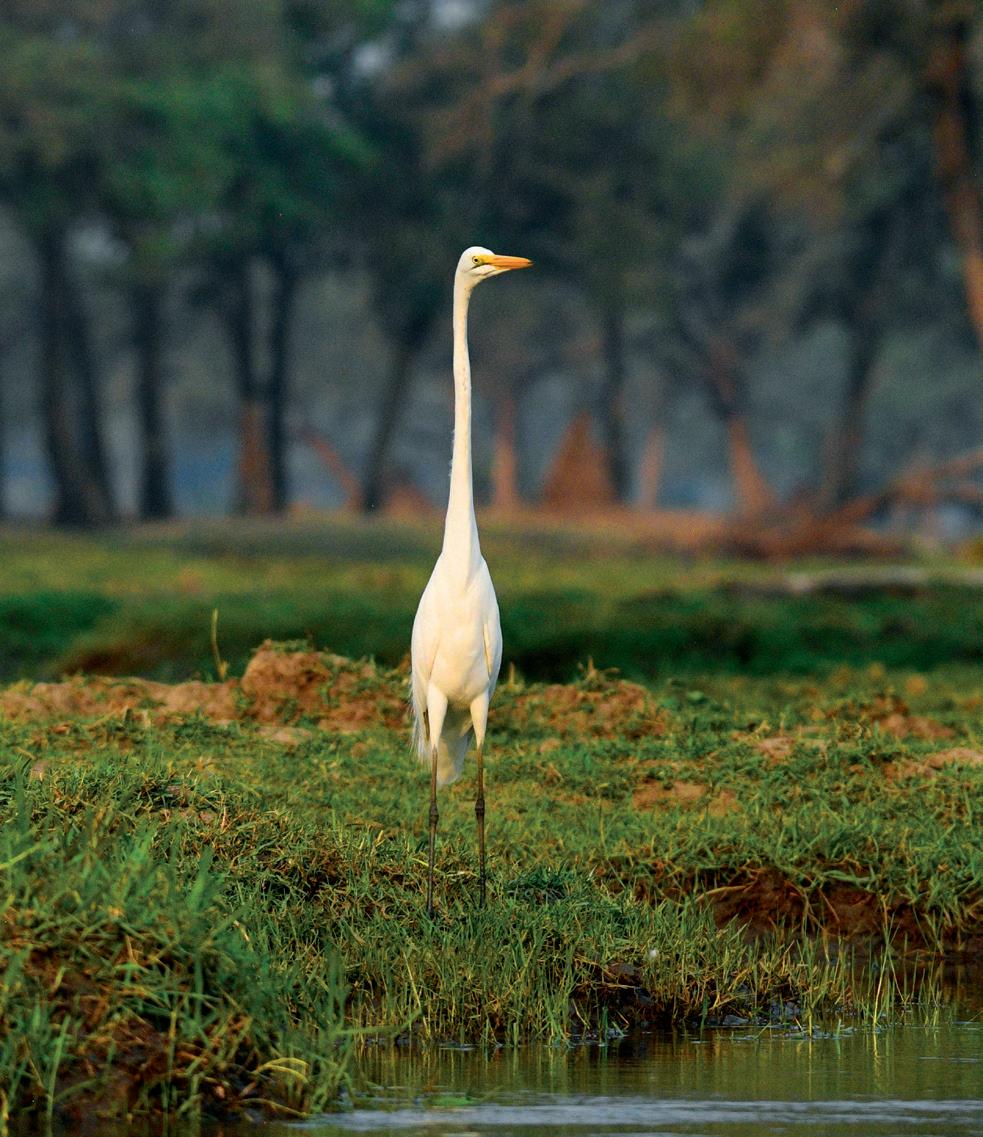
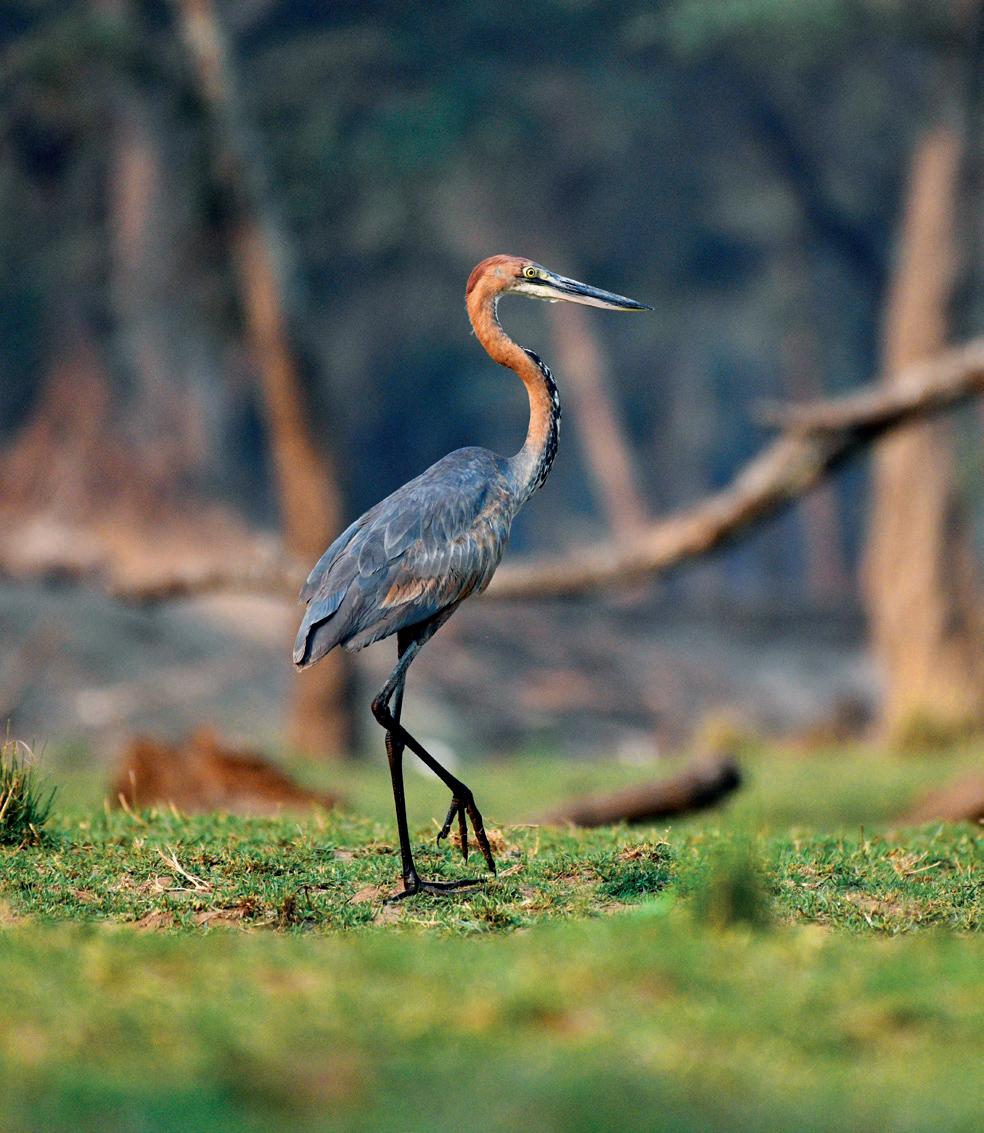
24 TRAVEL PORSCHIST
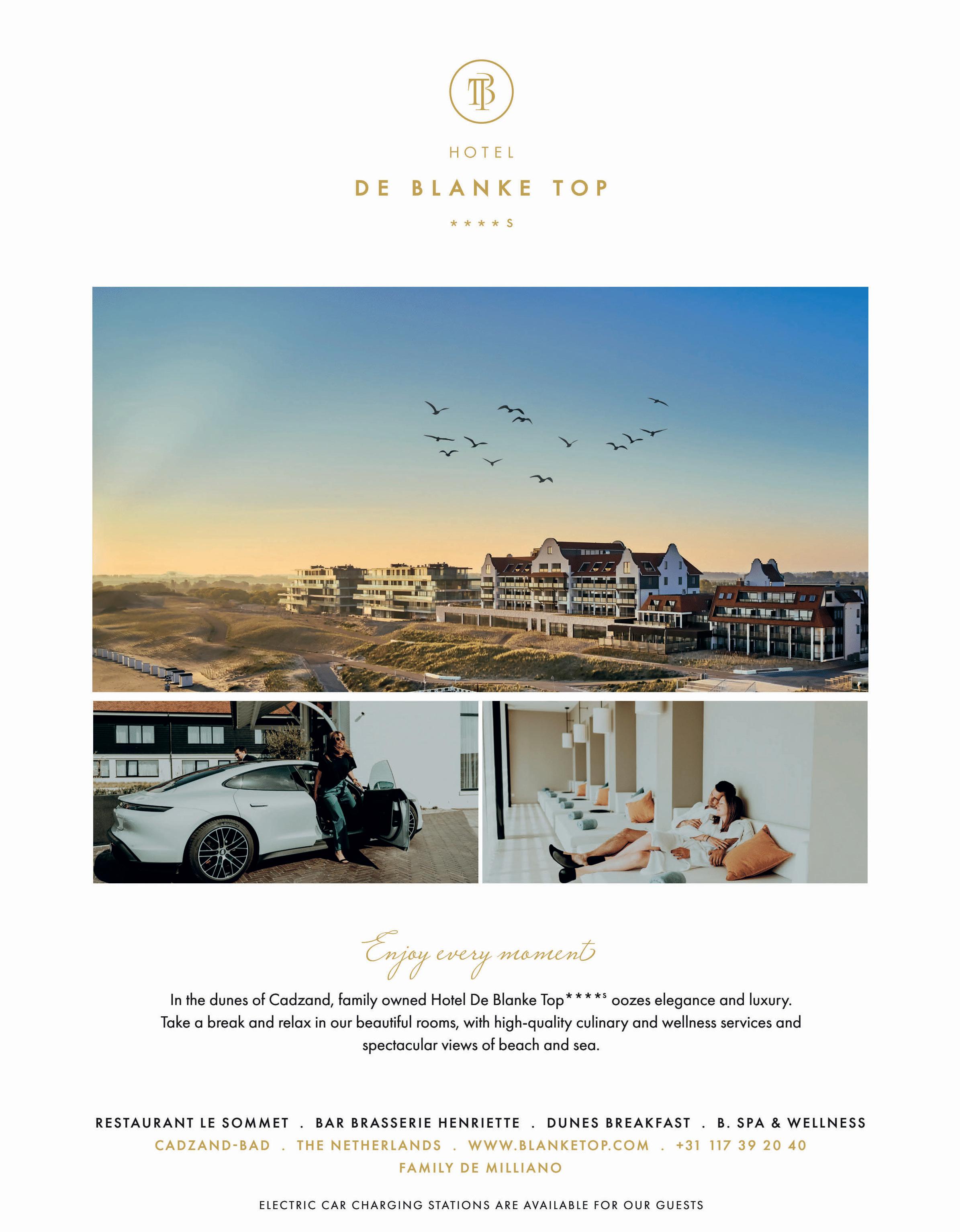

LOLEBEZI: A LUXURIOUS CONTEMPORARY LODGE
We take the boat to travel to our next place of residence. From Kutali it is only a twenty minute boat ride on the Zambezi to Lolebezi, another camp in the Lower Zambezi National Park. A greater contrast between the two camps can hardly be imagined. Lolebezi Lodge is luxury in the superlative. A beautiful stone main building with wooden spiral staircase and impressive ornaments is the first place we enter. A marble bar catches the eye. The inviting seating areas offer sofas with round shapes, mainly in shades of green, a colour that naturally blends in seamlessly with the surrounding nature. No tents here, but oversized bungalows with all the trimmings. Even air conditioning - which, to be honest, we're quite pleased about. It is almost unbelievable that this architectural gem is located in the middle of the bush. Yet Lolebezi also only has four suites and two family units. Here too, everything is wonderfully small-scale.
TRAVEL PORSCHIST


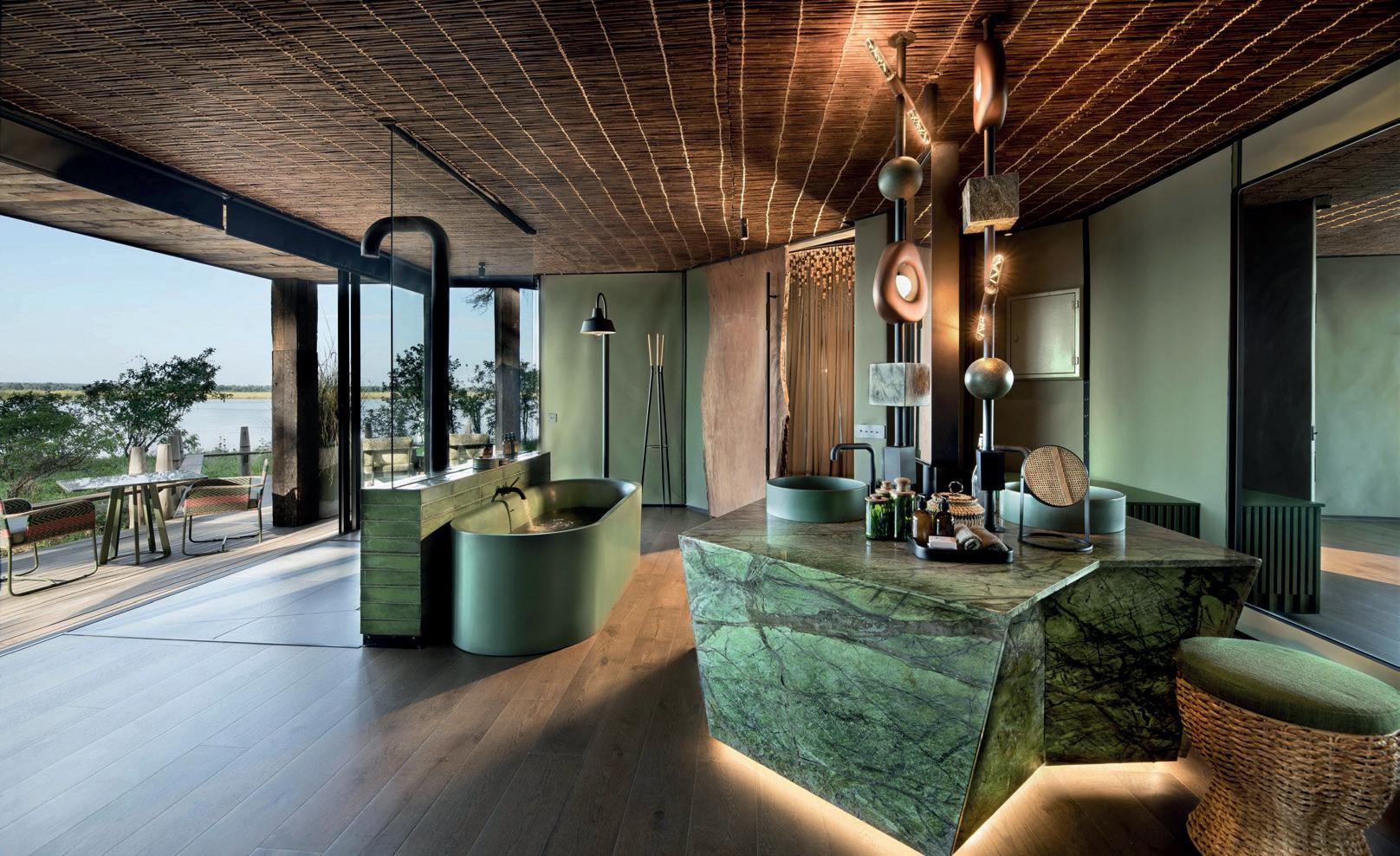
27
Lolebezi Lodge is luxury in the superlative.
Lolebezi Lodge, Lower Zambezi National Park.

THE KING OF THE ANIMALS
A new lodge means a new private guide. James introduces himself and invites us along. In the morning, a pride of three lions - two males and one female - had killed a waterbuck. James soon finds the males again. The lioness is probably somewhere with her cubs. The animals have dragged their prey under a mahogany tree so that they can continue eating in the shade. The carcass is already completely torn open. Dark red flesh around white bones. Just now, the lions are lying stretched out next to the carcass, panting as if they have run a marathon. “The heavy breathing is partly due to the heat, but mainly because lions are very greedy,” James explains. “They eat so much each time that their stomach reduces the lung capacity and they take in less air. They have to rest every time after they have gorged on food.” Already, some twenty vultures have gathered in the trees, patiently waiting for the leftovers. To try and take a piece now would be suicide. Lions are selfish and do not like to think of sharing their meal. Vultures mainly eat animals that have died due to old age or disease. This way they clean everything up neatly. They have so many acids in their bodies that they can digest almost anything. Just like hyenas. In this way, both species prevent diseases from spreading among other animals and play a crucial role in maintaining ecosystems. The bad reputation of vultures and hyenas has now been corrected.
28
TRAVEL PORSCHIST
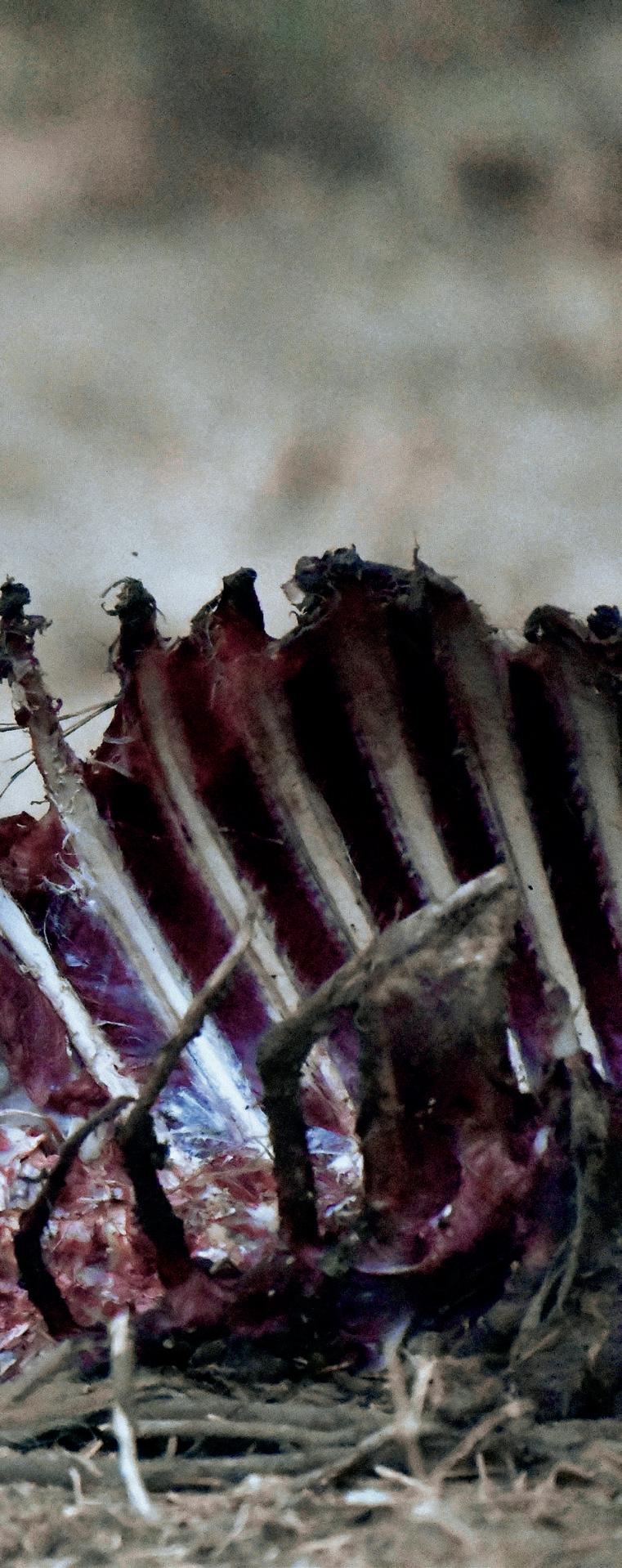
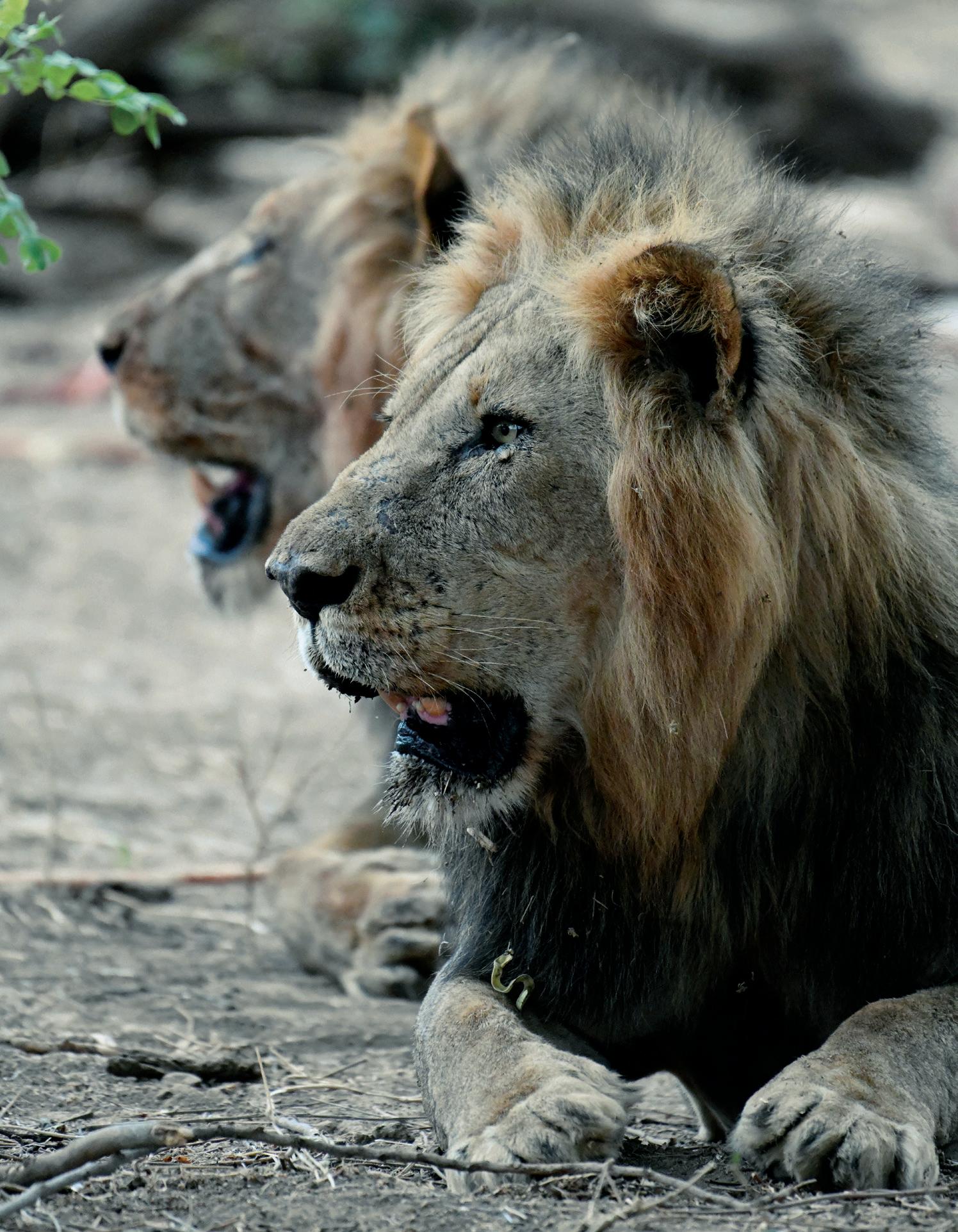
An adult male elephant approaches. “Great,” says James, “this could be interesting. The lions are sated and now have no energy to fight if that should become necessary. Elephants and lions have a special relationship. They don't like each other. Probably because they are evenly matched. Lions sometimes dare to attack a young elephant that is alone, but if there is an adult elephant nearby, they come face to face with a fearless opponent.” Only when the bull is about two metres away from the lions do they notice his presence. They raise their heads and appraise the visitor. A faint, low growl starts up deep in their throat. The elephant is not impressed, shuffles past them and quietly continues on his way. It's fantastic that we can watch all this up close. And all by ourselves. No other jeep that we have to make way for or that disturbs the scene. We're in the middle of an episode of National Geographic Wild. Zambia is fantastic.
29
OBSERVATIONS FROM THE AIR
We leave the Lower Zambezi National Park and head to another park. To do this, we first have to fly back to Lusaka and take another bush flight from there. The flight is breathtaking. We see the many overgrown sandbanks in the Zambezi River that lie like islands in the river and the countless tributaries that meander crisscross through the land, as if scribbled on it by a child's hand. After the river come the mountains. Not steep and angular, but rounded and sloping with a wide range of colours of brown, green, ochre and burgundy. As we fly further we see the first signs of human activity: here and there a house and some modest agricultural plots that soon grow into villages with asphalted roads. Factories and immense greenhouses start to pop up. Finally, the busy conurbation of Lusaka appears. We find it very fascinating to observe the transition from unspoilt nature to urbanisation from the air.
From the air we see the many overgrown sandbanks in the Zambezi River that lie like islands in the river and the countless tributaries that meander crisscross through the land.
SOUTH LUANGWA NATIONAL PARK : DISTANT WILDERNESS
From Lusaka we travel straight back to the South Luangwa National Park. Here too, a river is the most important lifeline. The Luangwa has its source in the Tanzanian highlands and flows a thousand kilometres further south at the three-country point of Zambia, Zimbabwe and Mozambique in the Zambezi. ‘The Valley’, as South Luangwa is also known, is said to be one of the last remaining true wildernesses. The volcanic subsoil and erosion of the landscape have resulted in different ecosystems. Vast savannas, tropical lagoons, forests and river landscapes alternate. The presence of all these ecosystems and food sources also ensures high game numbers here.

30
TRAVEL PORSCHIST
porsche design

Follow Your Vision. PATRICK DEMPSEY WEARING THE P'8970 SUNGLASSES.

CHINZOMBO CAMP: AWARD-WINNING DESIGN
The third camp of our trip is Chinzombo. Again, a completely different look and feel. The camp is located on 24 hectares of private land and was completely renovated ten years ago by a renowned architectural duo. It reopened in 2013 as a luxury camp. And it is certainly luxurious, but in a minimalist way with a sleek design and organic textures. Only regional materials and indigenous construction methods have been used. Everything in this lodge runs on solar energy. It is striking how the entire safari experience in Zambia has been developed with the greatest respect for people, animals and nature. The design of the camp has already received several awards. The six guest tents – we can call them 'villas' – are very spacious, with an ingenious eco-cooling system above the bed. A plunge pool and a cozy lounge area await us on the wide veranda. The unobstructed view of the winding Luangwa River is magnificent. In the evening the tent can be closed with sliding doors, but during the day they remain open, which provides
TRAVEL PORSCHIST
Chinzombo Camp, South Luangwa National Park.

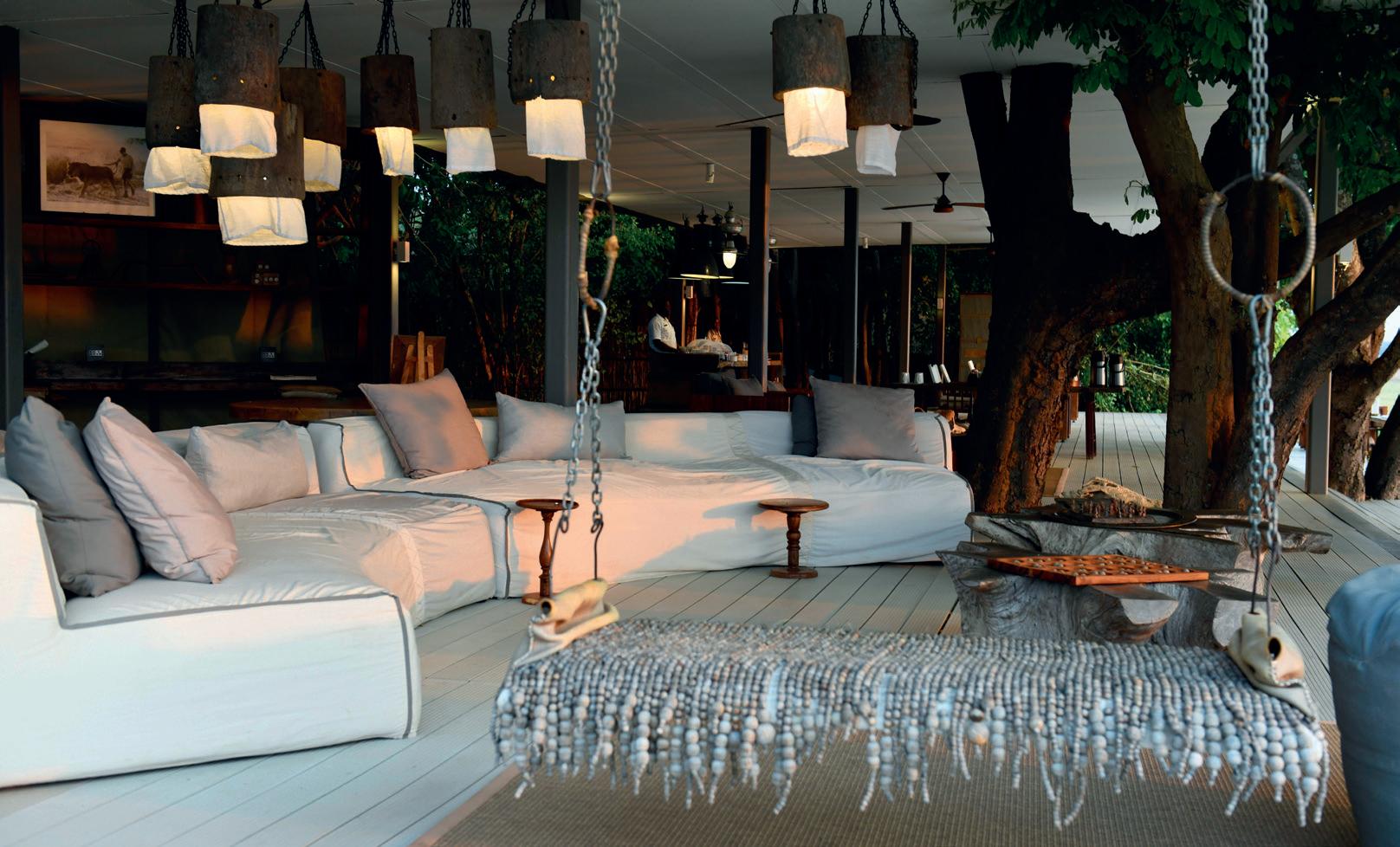

Chinzombo Camp is a beautiful luxury camp with a minimalist design and extensive use of organic textures.
an enormous feeling of freedom and connection with nature. What we do have to take into account are the mischievous, grabbing vervet monkeys. They lie in wait and are only too happy to sneak in and steal something. We are advised to put small items away. When we are not in the tent, a guard with a catapult in his hand keeps watch. Although that is a lost battle from the start. The monkeys are much faster than the keeper. When he chases away a monkey on the left, another quickly rushes in on the right. An entertaining spectacle. A winding path leads to the central tent where the food is served. In the open-air library, yellowed books and old photos refer to Norman Carr, the man who founded the camp in 1975.
33
TRAVEL PORSCHIST
THE LEGENDARY NORMAN CARR: CONSERVATIONIST AND SAFARI PIONEER
Norman Carr (1912-1997) was a special man. The Mozambique-born Brit was passionate about nature and a pioneer in the field of nature conservation. As early as the 1950s he played an influential role in establishing national parks in Zambia, Malawi and Zimbabwe. He was already working on 'ecotourism' before the word even existed. He initiated a visionary conservation concept that paved the way for modern nature conservation and sustainable tourism. At a time when safaris were a track-and-hunt tradition that made a lot of money by killing animals, he created a system to charge tourists for protecting and preserving wildlife and their natural habitat through the establishment of tented camps. A formula that caught on. The tented camps of that time are still there - now equipped with modern comfort. We find it very special that we are staying in a place that was once the home of this inspiring pioneer.
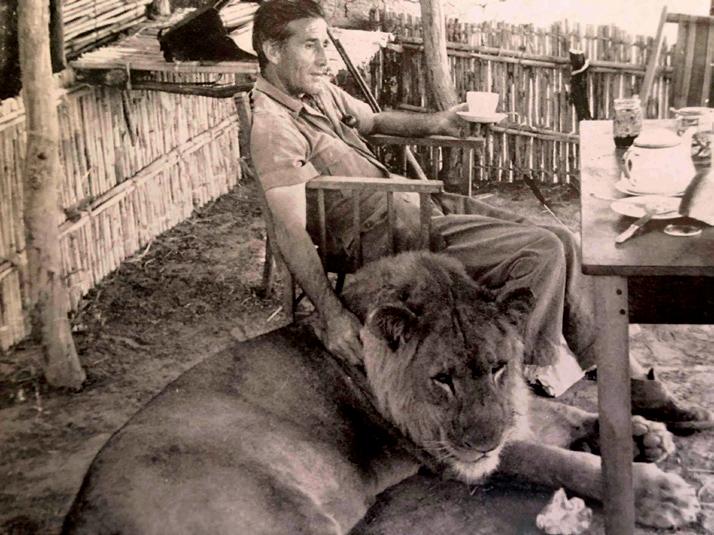
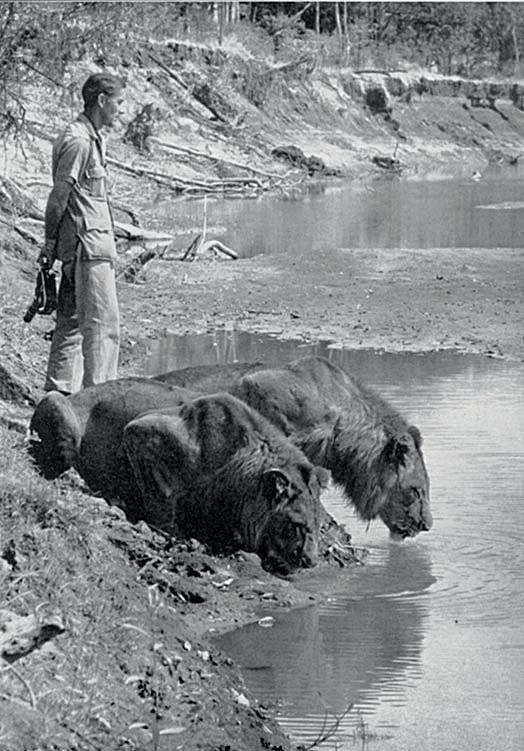


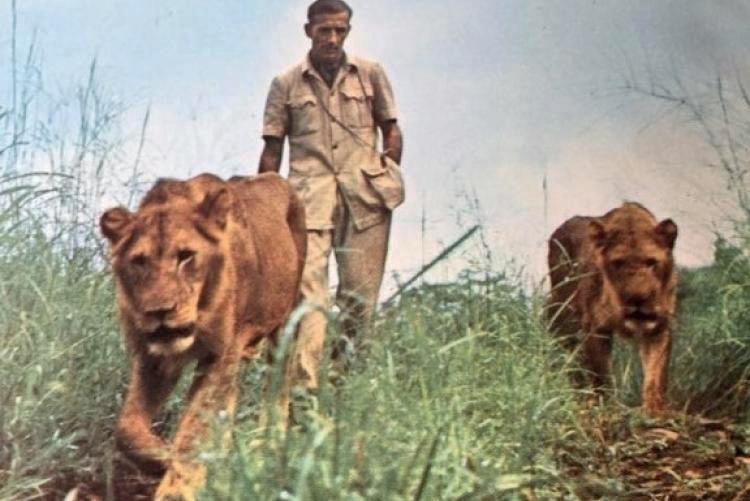
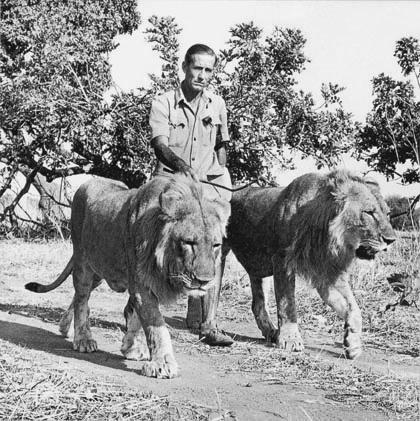
Norman Carr was a pioneer in the field of nature conservation and ecotourism.
THE HEARTWARMING STORY OF CHRISTIAN AND BOY
Carr's love for animals was so great that in 1958 he took care of two orphaned lion cubs. He called them Christian and Boy. Soon, they acquired the nicknames Little Boy and Big Boy. The two cubs were lovingly raised by Norman and his wife and grew up freely with them. Photos show Norman holding both cubs in his arms. In other photos – little ones grow up – we see an adult Christian standing next to Norman on the roof of a jeep and Chris lying next to his chair while drinking coffee. Amazing portraits. When they were three years old, Norman set them free. According to him, they were ready to take care of themselves. He still followed them from a distance and noted with satisfaction that his friends were doing well. The release of the two animals was a remarkable experiment and an early example of lion rehabilitation. The moving story was captured in the documentary Return to the Wild.
34


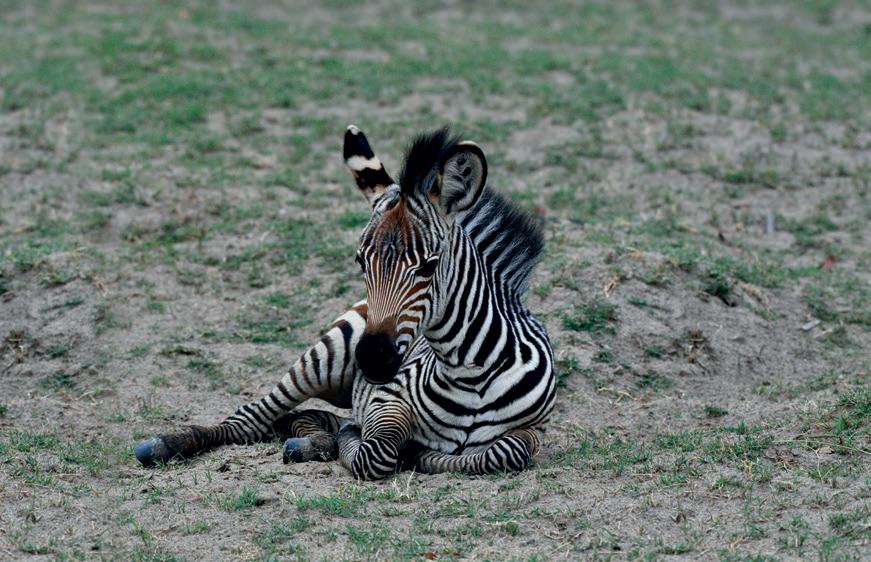
WALKING SAFARI: FOR THOSE WHO DARE
As if all that weren't enough, Norman Carr is also considered the founder of the walking safari concept: heading into nature on foot to explore the African wilderness. We have never done it, because it is not offered everywhere and it also seems quite dangerous to us, but if we have to test it out in one place, it is here. For this you need trained company with nature experience. Our guide Philip leads the way and behind us there is a ranger with a rifle in case something goes wrong. “Which won't happen,” Philip assures us. “Animals are only dangerous if they are approached incorrectly.” It is still early in the morning and the savannah is bathed in a honey-coloured light. We walk across plains, through knee-high grass and riverbeds. All our senses are on full alert. We feel small and vulnerable, but at the same time we think it's fantastic. We are no longer spectators, but participants. We study tracks and listen carefully to the different sounds. Our adrenaline levels skyrocket when we discover a herd of elephants. We stand quietly and see how the little ones drink from their mother and hook their trunks together as a sign of friendship. A little further on, a zebra cub sits in the grass. It looks at us curiously and doesn't even startle when our camera clicks. For the first time on this trip we also see giraffes. The Luangwa Valley is home to a special species that cannot be found anywhere else: the Thornicroft giraffe. The animals are smaller than other giraffe species in Africa and their pattern of spots stops at the knees, making it appear as if they are wearing knee socks. One of the males is in heat and is very excited to mate. He has set his sights on one of the females and follows her relentlessly. However, the lady is not interested and his request is rejected. A little one is drinking, its long stilts spread out. A long neck is useful for eating juicy leaves from the tallest trees, but quite tricky if you have to bend down. When we get back to camp we notice that we are extremely tired. Not so much from the effort, but from the intense experience of all these encounters in the wild. We will remember it forever: a walking safari is the best way to really experience the African bush.
35
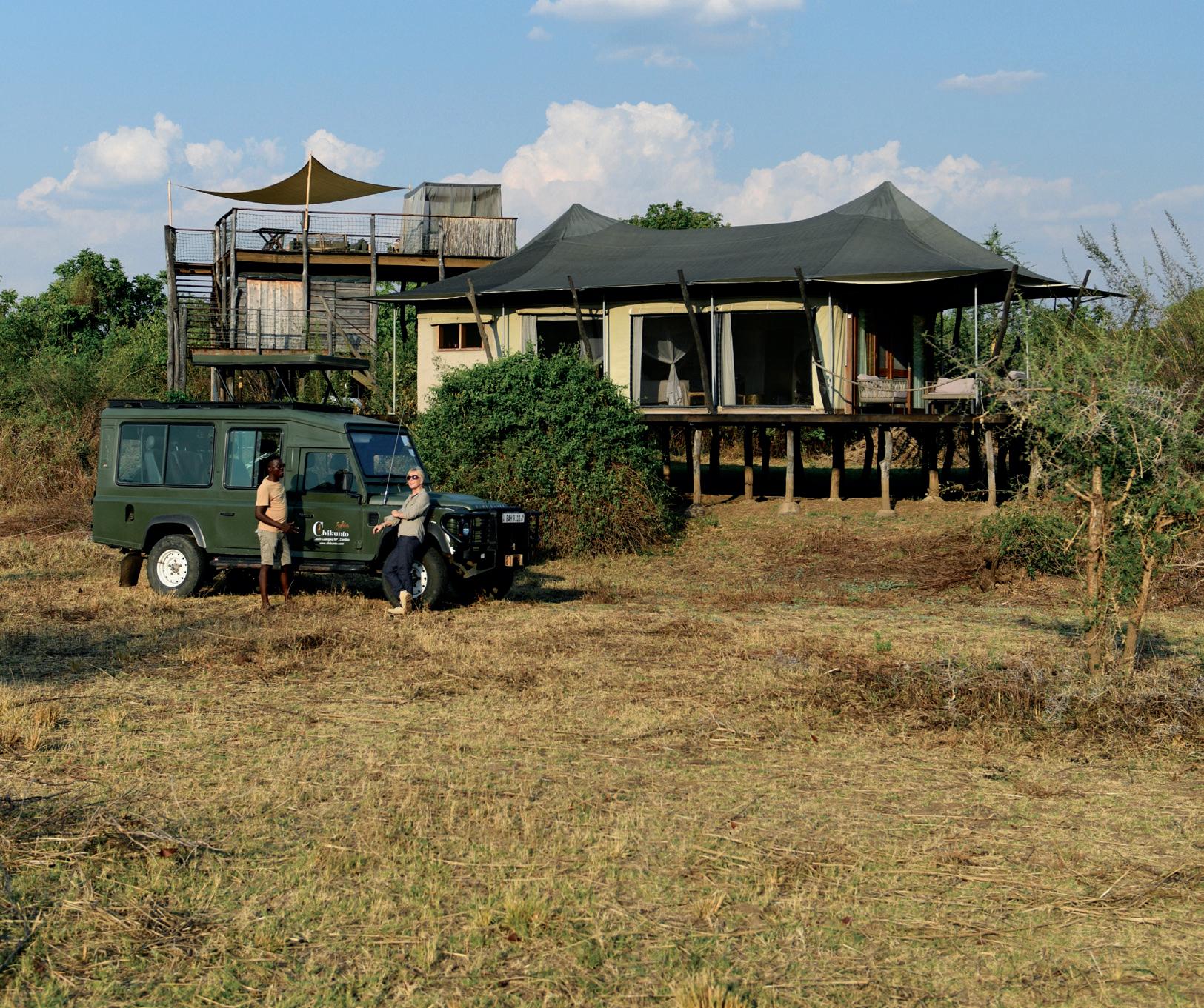
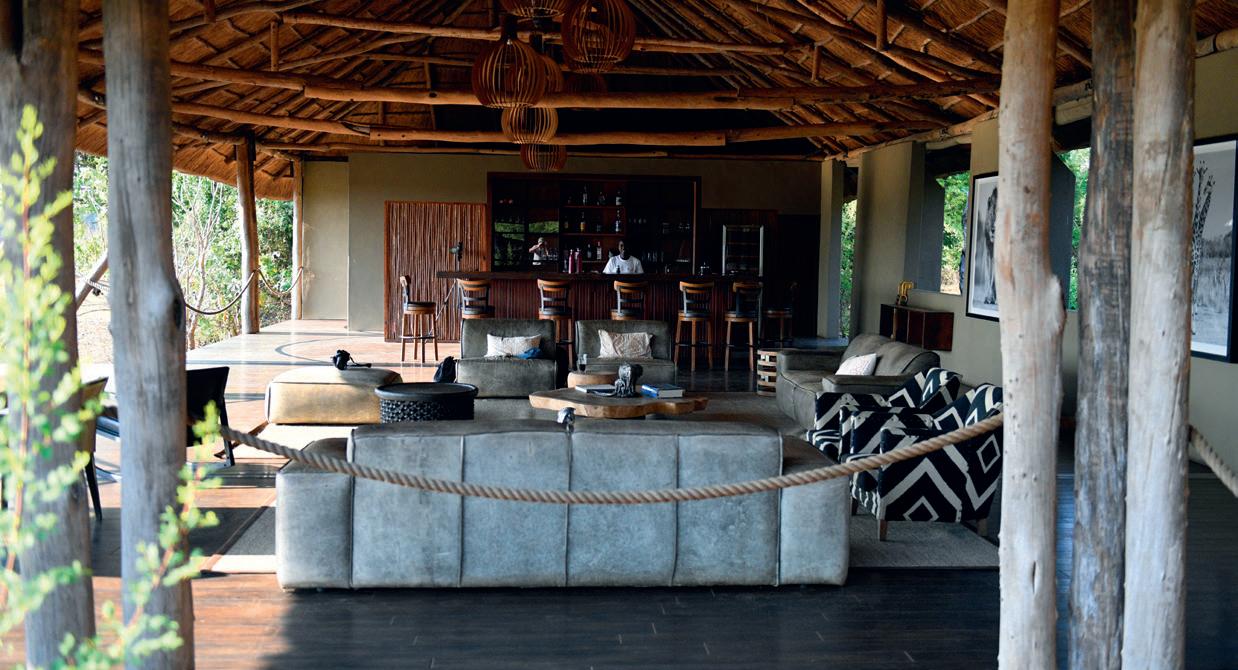
CHIKUNTO SAFARI LODGE: TRADITIONAL TENTED CAMP
Chikunto – our fourth and final camp of our trip – is also located in the South Luangwa National Park. We drive there overland. The ride is a feast for the eyes once more. We manage to immortalise a puku. The horns of the male are beautiful. We drive past ponds where hippos lie hidden among fresh green water lilies. The flowers stick to their heads like a crown. There are many lagoons and therefore a remarkable number of birds. Countless herons stand stately at the water's edge. When the driver makes radio contact after two hours, we know that he is reporting our arrival. The camp manager is already waiting for us. Friendly eyes and a greying beard. With his calm presence, Greg somewhat resembles Morgan Freeman. The spacious main room of the Chikunto Lodge is decorated with eclectic African-European style furniture. Beautiful photo frames by the famous wildlife photographer Patrick Bentley adorn the walls. The five tents of the lodge are completely immersed in the vegetation, which is denser here than in the other camps. The tents are connected by wooden decking that is interrupted here and there so that wildlife can pass through. We stayed in lavish luxury for a few days at the Lolebezi Lodge and the Chinzombo Camp, but now the accommodation is simpler again. And that is fine by us because in such a 'normal' tent, the experience of nature is just that little bit more real and exciting. Our tent is the last in the line and comes with an addition. A wooden staircase leads to a four-metre high platform. A lookout tower, we think, but no, it is an extra sleeping place with a four-poster bed and mosquito net. In our last lodge we can literally sleep under the African starry sky with the intriguing sounds of the jungle in a lifelike surround system in the background. We can assure you that this is a unique experience.
36 TRAVEL PORSCHIST
Chikunto Safari Lodge, South Luangwa National Park.

IN THE EYE OF THE LEOPARD
Our last game drive. “Anything on the wish list?” our guide asks, laughing. We love all animals big and small, but we think a leopard is the most beautiful. “Let's see if we get lucky,” Money replies. And we do. The big cat sits in the straw-yellow grass and completely blends in with the colours of the surroundings. It's a female. After a few minutes, she walks slowly to our jeep and ambles around it completely unconcerned. We hold our breath. She's so close we could actually touch her. We can hardly believe this is actually happening. She walks away and lies down a little further away on a thermite hill like an accomplished diva. We remain standing for a long time, looking at her full of admiration.
The leopard's spot pattern blends completely with the environment.
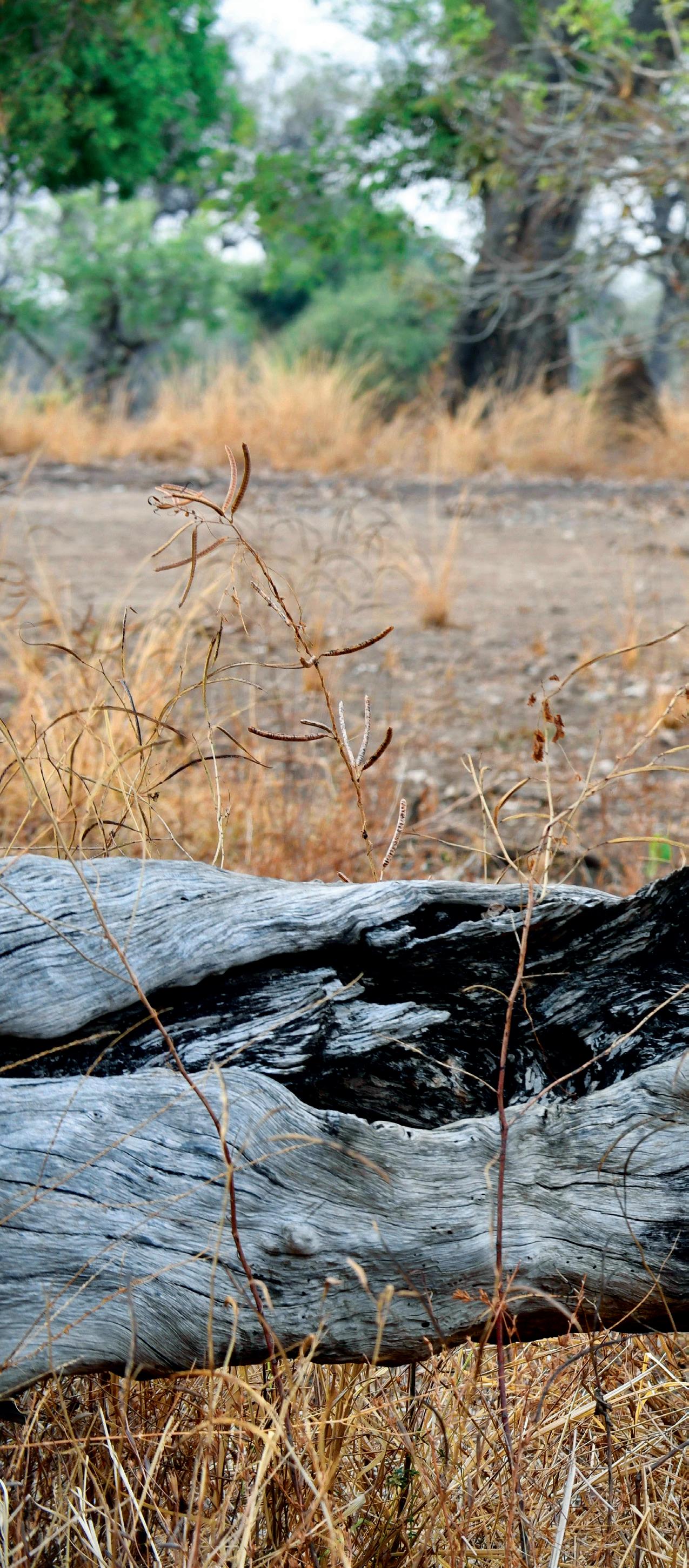
38 TRAVEL PORSCHIST

ANOTHER UNEXPECTED ADDITION IN LUSAKA
Unfortunately we have to say goodbye to nature, but there is still a bonus waiting for us in Lusaka. The advantage of safaris is that you can easily make contact with fellow travellers. When you sit together by the campfire in the evening and stare at the stars, it's only natural to start a conversation. For example, in our third camp we spoke to a Cypriot couple who have been living in Zambia for eight years. When they heard that we worked on Porsche magazine, the man immediately said: “My friend drives a 944. He will definitely want to meet you in Lusaka.” And so it happens that, on the day before our return to Belgium, we have a conversation with Nick Frangeskides and we were able to take beautiful photos of his car beneath a bright red canopy of exuberant flame trees. Moreover, Nick has brought some wonderful company with him. Gift Muneka is a well-known Zambian actress who is active both on stage and on screen. With her traditional colourful African outfit she is the proverbial icing on the cake.
A bonus photo of a red Porsche 944 beneath a canopy of flame trees.

40 TRAVEL PORSCHIST
Gift Muneka, famous Zambian actress.
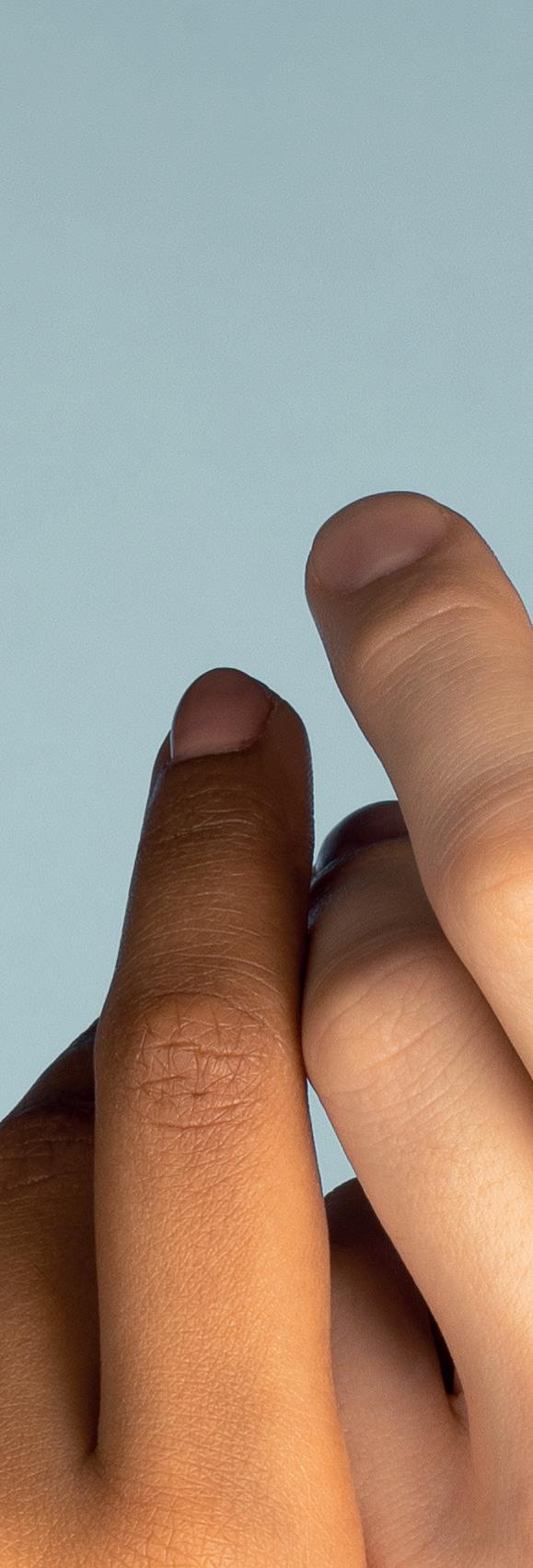















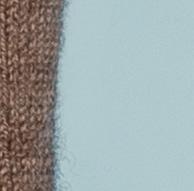

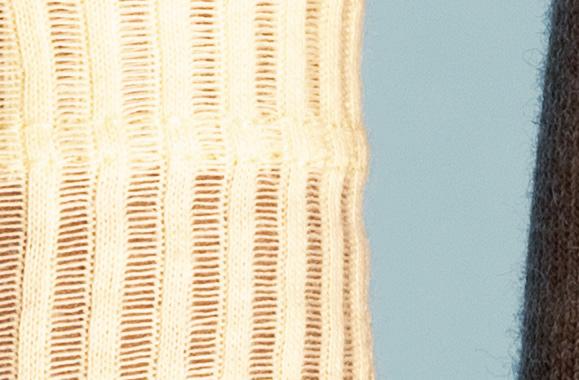



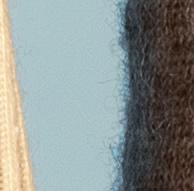

WWW.VANESSER.COM 2000 ANTWERPEN - SCHUTTERSHOFSTRAAT 32 - INFO: 03-236 31 84 3500 HASSELT - KAPELSTRAAT 17 - INFO: 011-22 32 50
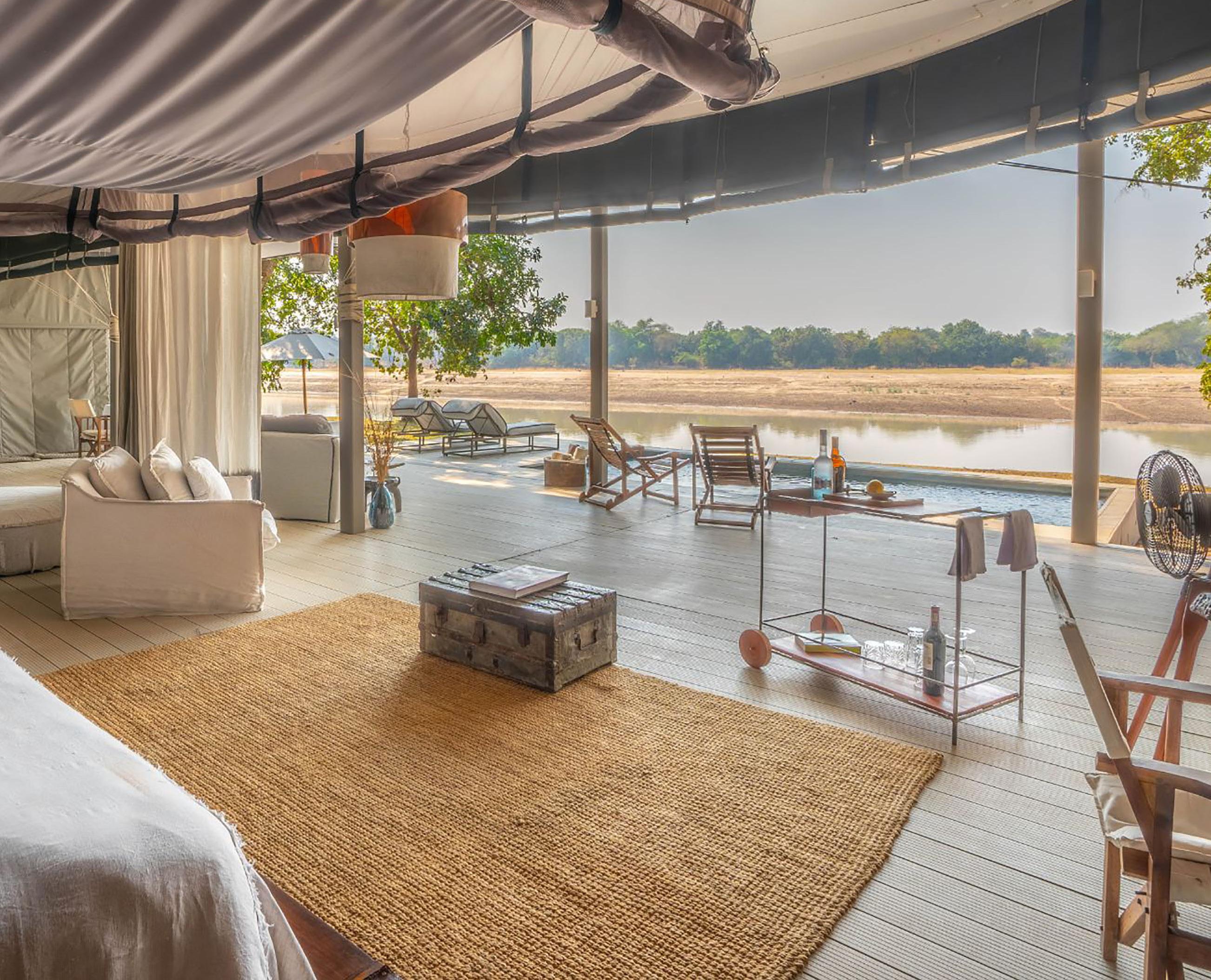


Vera Van Steenvoort • Tel. 0475-36 00 27 • vera@advalorem.be Braziliëstraat 10 • 2000 Antwerpen • www.advalorem.be Where horizons know no end….
FAREWELL TO ZAMBIA
We can now confirm: Zambia is truly pure Africa and a real hidden gem. Nowhere have we seen so many wild animals as here in this still undiscovered safari country. The fact that the lodges are small-scale is only an advantage. The service is personal and attentive and the local guides are easily among the best in the world. It is therefore strange that so few safari travellers have discovered this country, but of course also a great bonus. ♦

Thanks to :
- Vera Van Steenvoort www.advalorem.be
- Zambian Ground Handlers, Nick Aslin
- Mr. Rodney Malindi Sikumba, Minister of Tourism Zambia
- Mr. Roy Ngulube, Clerk of the National Assembly Zambia
- Oscar Chavula and Nick Frangeskides, two proud Porsche owners
- Ms Gift Muneka, Zambian actress
PORSCHIST TRAVEL

Oscar
Chavula
Versatile entrepreneur with a sharp eye for opportunities.
Text: Kathleen Van Bremdt - Photos: Sven Hoyaux
scar Chavula is one of Zambia's leading entrepreneurs. He owns an impressive list of businesses in various sectors. Through his many business successes, he has built a powerful network. He is friends with just about everyone who matters in Zambian public life and has connections to the highest levels. As a result, he actually gets us to photograph his yellow Porsche 911 in front of the parliament building.
You are an established entrepreneur who has already achieved a great deal of fame and recognition. Where does your business talent come from?
Entrepreneurship is in my blood. I see opportunities everywhere and have no fear of venturing into areas unknown to me. Setting up companies is only something from the last 20 years. I worked abroad for a long time. Before returning to Zambia in 2003, I worked as Area Manager at Gobel & Partner Ltd. in Birmingham, a leading multinational quality management company. The company guides clients to achieve the highest possible quality standards, improve efficiency and reputation while reducing costs. It is a fascinating process from start to finish. As an engineer, I had the right knowledge to assist companies in this process. My portfolio included - perhaps not coincidentallyautomotive clients such as Toyota, Honda, BMW and Mini.
44
Oscar Chavula.
Once back in Zambia you started setting up your own businesses.
I started in the media business, a sector that has always intrigued me. In 2005, I founded HOT FM, a radio station. A few years later, other radio stations followed as well as HOT TV, a television channel. Since two years, there has also been Zizwa+, a film and streaming service. Besides that, I am also active in the mining industry with my company Oscarios Mining & Exploration. We focus on gold and emeralds. I am also Executive Chairman of Boltz Technologies, a manufacturer of computer hardware and with Kwithu Travel & Tours, I am in the travel business. I also find real estate an interesting business and I do business in that too. I really take pleasure in being involved in multiple areas at once.
And besides that, there is Porsche. What makes this car brand so special to you?
I bought my first Porsche when I turned 30. That was in 2003. It was a Boxster. I have always admired Porsche, but surprisingly had never driven one. However, from the moment I took the wheel and could experience how much driving pleasure the car delivers, I was instantly hooked. There really is no other car brand that can match the fantastic driving experience a Porsche offers. And I can compare well, because I have owned other top cars like Bentleys and Lamborghinis, but I can say in all honesty that Porsche outclasses them all.
After the Boxster came a second Boxster and then a Macan. Currently I have two 911s: a yellow 992 Targa and a brown-black 993 metallic. A 911 is very versatile. In town, I drive it quietly like a 'normal' car so to speak, but when I crave speed and power, I only need to press the accelerator to let the sporty character of the car come alive. A Porsche connects driving styles. With both the 992 and the 993, I feel like I melt with the car when I drive it. It is as if the car thinks with me. The steering is direct and sharp, the handling perfect and the acceleration unparalleled. Behind the wheel of my Porsches, I really feel at home. That makes them so special.
'A Porsche connects driving styles. It is as if the car thinks with me. The steering is direct and sharp, the handling perfect and the acceleration unparalleled.'
Oscar Chavula
Where did you buy your Porsches?
Always at Ramus Porscha in Birmingham. When I was still working for P&G, I lived in Birmingham and Ramus Porscha had - and still has - a very good reputation. Even when I was back in Zambia, I continued to buy my Porsches from them. Firstly, because I had built up a very good relationship with the company over the years and secondly because the steering wheel of their cars sits on the left. Just like in the UK, we drive on the left in Zambia.
What are the roads like in Zambia?
I know the city like my inside pocket and 95% of the roads are good or - let's say - good enough for my Porsche. Outside the city, you have both good and not so good roads depending on the region you are in. But I don't think roads should be a problem. Everything has to do with how well you know your car and how well you can drive it.
45
PORSCHIST INTERVIEW
Are there speed limits?
There are, but to be honest, they are not particularly taken into account. If I want to have a good time behind the wheel, I can ask for the road to be closed to me. For instance, on a Saturday morning, when there is not much traffic.
Do you have any idea how many Porsches there are in Zambia?
As for 911s, there are only two in the whole of Zambia and they are both mine. (laughs) There are still some Cayennes and Macans, but the number of Porsches in Zambia is really limited.
'There really is no other car brand that can match the fantastic driving experience a Porsche offers.'
Oscar Chavula
You are a businessman at heart. Don't you have an ambition to start a Porsche dealership?
I must admit I have thought about it, but I think it is still just a little too early. I know enough people who can afford a Porsche, so there is definitely a market. Let’s say I keep it under consideration.
Is there a Porsche club in Zambia?
Not yet. There are too few Porsche owners for that, as I already mentioned. But it might be something for the future.
With you as president?
I suppose so. (laughs)
How do you approach the maintenance of your Porsches?
I am an engineer and therefore technically well versed. Moreover, I have worked in the car industry. I have enough know-how to keep my Porsches in top condition. The nearest official Porsche Service Centre is in Johannesburg. It would not be convenient if I had to drive over there for every maintenance or technical problem.
You are active on so many fronts. Is there still a new adventure awaiting you?
To be honest: I just turned 50 and that is quite a milestone for me. I have worked extremely hard all my life with little or no time for holidays. I think it's time to change that. I am currently looking for a place where I would like to live within this and four years. It probably won't be in Zambia. Right now, Cape Town is at the top of my list, but I haven't made my mind up yet.
One last question: Zambia is not well known as a tourist destination or safari country. Why is that so in your opinion? Zambia has everything our neighbouring countries have. The only difference is that Zambia has not put enough work into making that known. If you have a great thing but nobody knows about it, well, then it will not get you anything. Fortunately, work on this is in full swing. There are a lot of projects now to promote Zambia. Tourism is guaranteed to grow in the coming years. ♦
Thanks for this fine conversation.
46
INTERVIEW PORSCHIST
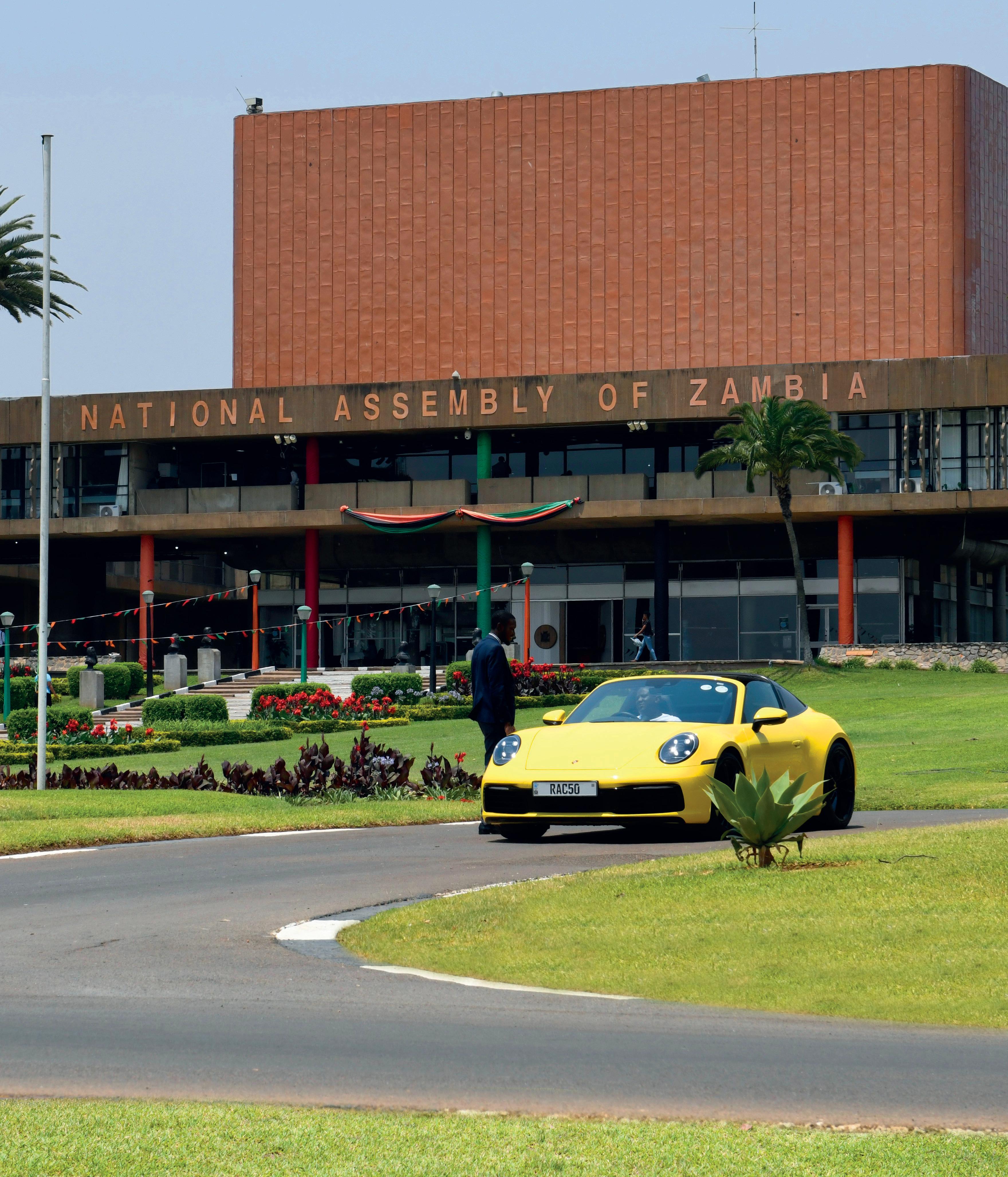

Rodney Malindi Sikumba
Minister with a mission.
odney Sikumba has been Minister of Tourism for 2.5 years. An important portfolio because Zambia has a lot to offer but is hardly known to the general public as a tourist destination. Rodney Sikumba is the right man to change that.
Text: Kathleen Van Bremdt - Photos: Sven Hoyaux
You are Minister of Tourism. What does your job consist of?
My job has two main focuses: putting Zambia on the map as an attractive tourist destination and preserving our natural wealth through efficient and targeted management.
How are you tackling this?
One of the focal points of my department is attracting foreign investors. Tourism is in its infancy in Zambia and we need external know-how and foreign exchange. Zambia is big and there are many opportunities. Our door is wide open to anyone who wants to establish a business in the tourism sector. We invite potential investors and develop incentives that make it easy for them to start activities in Zambia. We also look for suitable local partners. In addition, we are working hard to make ourselves known on the international market. Of course, that does not happen overnight. We are present at the ITB fair in Berlin, the world's largest tourism trade fair. This has already brought us good contacts. Furthermore, we are
48 INTERVIEW PORSCHIST
always looking for new avenues of approach and opportunities. Therefore, an article in Porschist Magazine is an interesting way for us to reach the Belgian market.
How important is tourism to the Zambian economy?
The tourism sector is gaining in importance. In the past, Zambia's economy was almost entirely dominated by copper mining. However, when the price of copper started to fall on the world market from the 1970s onwards, it became clear how dependent and vulnerable our economy was. We are now fully committed to diversification, and tourism is one of the new pillars, although it took until the beginning of the current century before it really took off. Zambia is a late bloomer when it comes to tourism. Neighboring countries like South Africa, Botswana, Zimbabwe and Namibia set a good example for us: African countries that manage to benefit from their natural beauty and generate a lot of money from the tourism sector. This is something Zambia should and can do too. We are now setting up a bunch of initiatives to promote and increase tourism. We are ambitious and aiming to deploy a tourism sector that will develop into a billion-dollar industry over time.
'We are ambitious and aiming to deploy a tourism sector that will develop into a billion-dollar industry over time.'
Mr. Rodney Malindi Sikumba
What are Zambia's main attractions?
The pristine beauty of its nature stands at the top of the list. Our national Parks boast diverse ecosystems teeming with wildlife and 700 species of birds. Zambia is one of Africa's best safari destinations and home to the famous Big Five: lions, elephants, leopards, buffaloes and rhinos. Zambia is also very famous for the breathtaking Victoria Falls, the widest waterfall in the world and one of the Seven Natural Wonders of the World. The fall forms our border with Zimbabwe. You can admire it from both sides, but the Zambian side is quieter allowing visitors to better enjoy its beauty. Besides Victoria Falls, we have around 4,000 other waterfalls that define Zambia's landscape. The Zambezi is Africa's fourth-longest river and the river to which my country owes its name. It is one of the least spoiled rivers in the world and provides enormous biodiversity.
In addition, I like to highlight our unique culture. Zambia has a population of 20 million people and is home to more than 70 ethnic groups. About 98% of our population belongs to one of these tribes. For a Zambian, ancestry is very important. The various tribes have different customs and languages, but we all live in harmony and respect each other's traditions. Our country's slogan is not without reason 'One Zambia, One Nation'. The many traditional ceremonies reflect our way of life. How we dress, how we play music, how we dance and what we eat: it all defines our unique identity. And Zambians take great pride in sharing this with visitors. Zambians are renowned for being warm and welcoming. We may not be a rich country, but we know very well how to enjoy life.
Is Zambia a safe country?
Zambia is one of the safest countries in Africa, according to the World Economic Forum's Travel & Tourism Competitiveness Report. We are a peace-loving nation. Politically, we are a stable country, unlike other African countries where there is a lot of political unrest.
49
How many national parks has Zambia?
Zambia has 20 national parks and 34 game management parks. Together, they cover almost a third of our total land area - about 225,000 square kilometers. The national parks are Zambia's calling cards. Our first national park, the Kafue National Park, was founded in the 1920s and formally established as a national park in the 1950s by the legendary Norman Carr. In Zambia, we understand that nature is our highest good and that we must protect it. This can only be done by fencing off areas where human activity is limited to controlled tourism. In the parks, timber harvesting and poaching are completely banned, allowing animals to preserve their natural habitat and endangered species to survive. Each park has different ecosystems and biodiversity. This is why it is so interesting for tourists to visit different parks. In the national parks, wildlife management and nature-oriented recreation go hand in hand.
Who manages the parks?
That is done by the Department of National Parks and Wildlife which is part of my ministry.

Do local communities benefit from tourism revenues?
Absolutely. People lived in the areas that are now national parks. We asked them to move, but they are compensated for that effort. A part of the revenue generated by the parks through entrance fees and other payments goes to the communities. They should not bear the brunt of our nature policy. Moreover, the national parks create jobs for local people: park rangers, guides, drivers, staff for the tented camps and lodges and so on. The labour income from these jobs creates more economic growth in nearby communities.
Are you noticing any growth in the tourism sector?
Of course, like so many other countries, we faced a huge downturn due to the covid pandemic. The good news is that we are now catching up in a big way. In 2019, we had a visitor number of 1.1 million tourists. For 2024, we are targeting a visitor number of 2 million. ♦
Thanks for this conversation, Minister.
50
INTERVIEW PORSCHIST
ZAMBIA


MANUFACTURE
Classic Power Reserve Big Date
BEYOND
CONVENTIONS

Antwerpen : TenSen Juweliers - Geel : Huybrechts Juweliers
Lanaken : Caenen Juwelier - Zoersel : Juwelier Christiaan Picard
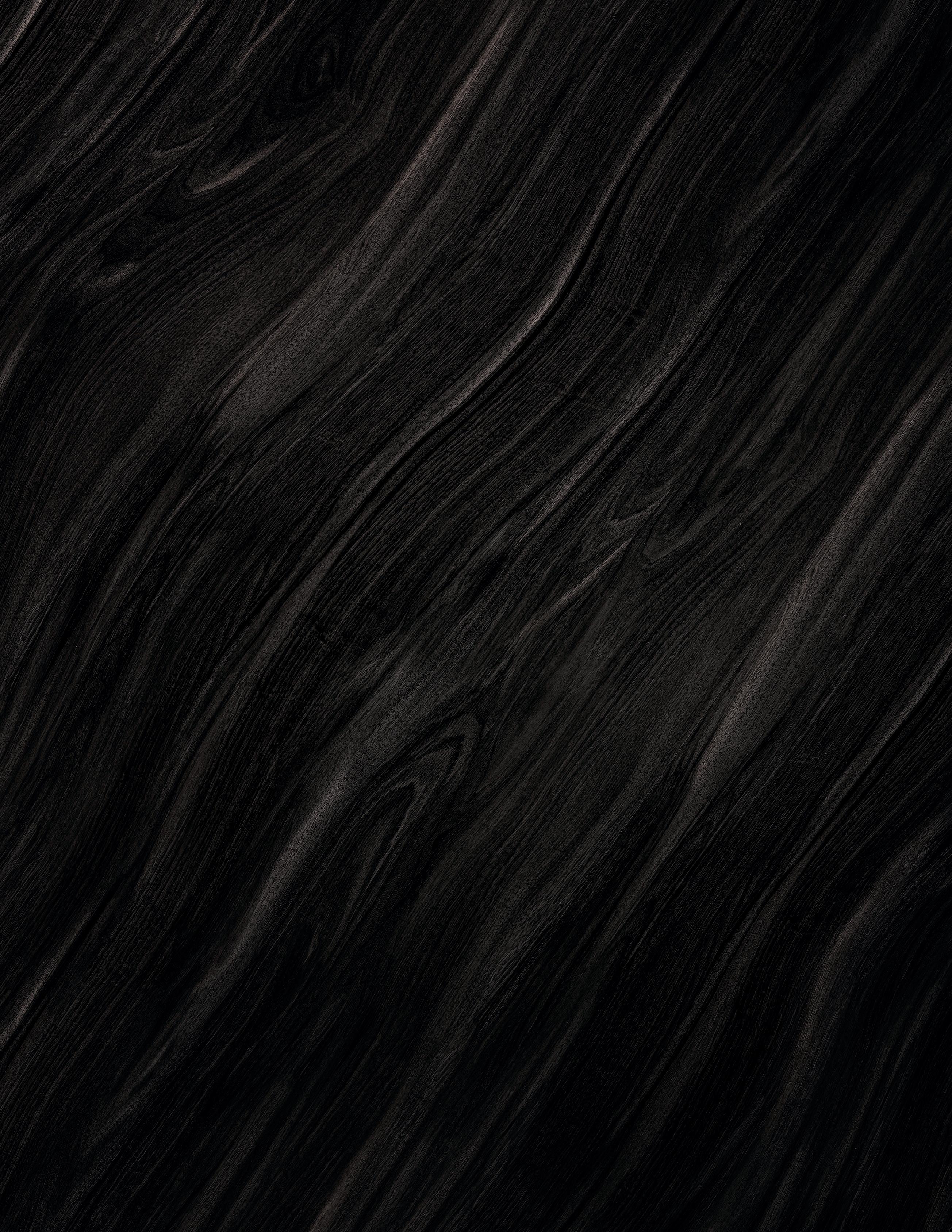

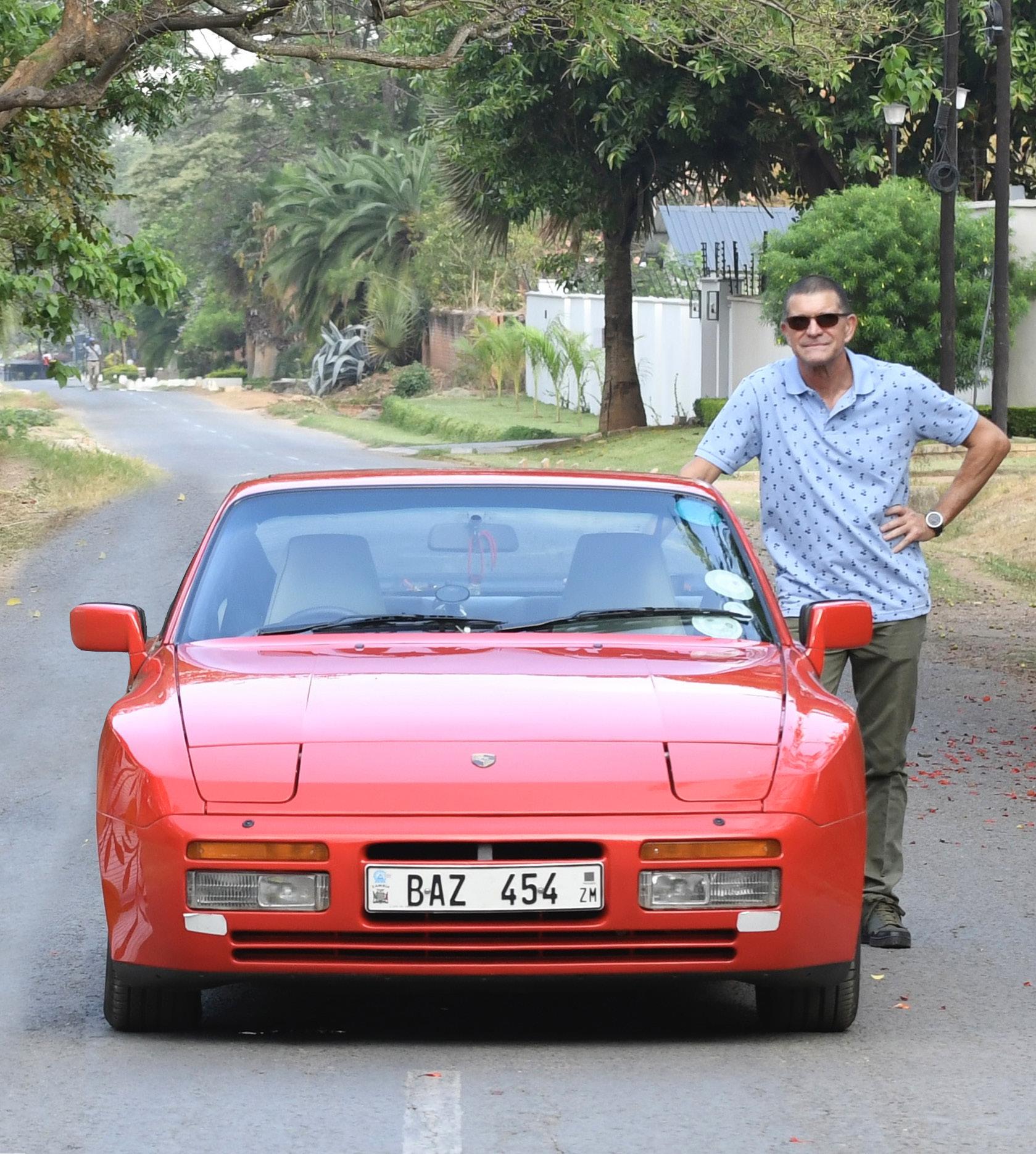
Interview Nick Frangeskides
Text: Kathleen Van Bremdt - Photos: Sven Hoyaux
othing like a classic Porsche on the colourful streets of Lusaka. Nick Frangeskides - a Cypriot by birth who has lived in Zambia all his life - has a beautiful 944 S2.
We are curious to hear his story.
You are of Cypriot descent. How did you end up in Zambia?
My father worked in the construction industry and came to Zambia in 1967 because he was working on a big project here. We came and stayed. I was 10 years old when we moved to Zambia. Of course, I had to adapt. Cyprus is an island, small and manageable, and suddenly I found myself in this immense country. I spoke only Greek and not a word of English. But as a child, you are flexible. Once I went to school here, had friends and learned English, I soon felt at home. For my university studies, I moved to London. Once I had my degree, I joined my father's construction company. My father sadly passed away a few years ago. Since then, I have been at the head of the family business.
Your company is called Velos Enterprises. Can you define your activities?
We are contractors and carry out large-scale construction projects across Zambia. We don't build houses, but focus on large buildings like shopping malls, factories, supermarkets, hospitals, churches and so on.
What are the challenges when running a business in Zambia?
Zambia is still a Third World country, which means things don't always run the way they do in modern countries. Everything goes a bit slower and more laborious. Workers are often unskilled, so it takes a bit longer for them to get fully involved. But Zambians are very nice people to work with. They are naturally very helpful, which ensures that the working atmosphere is always good.
How is the political situation in Zambia?
Very good at the moment. There was some tension for a while in the past, but now we have had a stable regime for several years. Zambia is a constitutional republic ruled by a democratically elected president. Unlike some of our neighbours, there is little corruption. Zambia is a peaceful and safe country.
‘My 944 S2 is still completely in original condition.’
Nick Frangeskides
What is Zambia's main source of income?
That is mining. Copper and cobalt are among Zambia's main exports. In second place is agriculture which includes cotton, coffee and maize. Zambia's economy is growing, but the population is growing faster, which means that a lot of people still live below the poverty line. The government is working hard to diversify the economy, but there is still a lot of work to be done. Zambia has a lot of potential in terms of tourism, but we seem to be failing to sell ourselves in the countries where the tourists should come from, especially the rich, industrialized countries. We have to compete with neighbouring countries like Namibia, Botswana and Zimbabwe that do already have a thriving tourism sector. That is not easy.
You have a beautiful Porsche.
It is a 944 S2 from 1991, coupé and with manual transmission. With its distinctive shape the car has an exclusive charm. The Porsche 944 S2 was presented in 1988 and production lasted only three years. The Porsche 944 S2 is therefore considered very exclusive as production numbers remained low due to its short life cycle.
I've only had the car since last year. I bought it in England mainly for practical reasons because the steering had to be on the right-hand side as required for Zambia. Unfortunately, the car had no air conditioning. In the hot climate here, you can't do without it. So I installed it myself. If you buy a classic car, it is useful to know a bit about car mechanics yourself.
53
PORSCHIST INTERVIEW
However, this is not your first Porsche.
No, I first had a Cayenne 4.5 Turbo S which I bought seven years ago. A fantastic car that I enjoyed a lot. Yet I sold it because I had to go to South Africa for maintenance every time. That became too expensive. I can manage to tinker with a classic Porsche, but there is too much high tech in a contemporary model. That ‘s work for specialists. And South Africa is quite a distance. I always had a 1,500-kilometre drive ahead of me. After a while, you get tired of that. Another problem is the quality of petrol in Zambia. It is not good enough for a luxury car like a Cayenne. So I sold the Cayenne with pain in my heart? I loved driving it so much. As a replacement, I was initially looking for a Porsche 928 but after some preliminary research, that car too turned out to be too complex to maintain myself. So eventually it became the 944 S2 and I haven't regretted it for a moment. Three months ago, the annual event for vintage cars took place in Lusaka. Around 70 cars took part. My 944 won the prize of most original car. In fact, the Porsche is still completely in its original condition.
With the exception of the air conditioning. Even that is original, because the system I installed is the one that would have been in the car if it had been equipped with air conditioning when it was initially produced.
What are the roads like in Zambia?
From fair to poor. (laughs) For the roads here, my Cayenne was much better suited. So when I'm out and about with my 944 S2, I always drive very carefully.
Is there a future for the electric car in Zambia?
At the moment, Zambia is not ready for electric cars, but eventually we will have to follow the rest of the world. There are also advantages to it. I just told you that the quality of petrol in Zambia is not optimal, but electricity is electricity, there are no gradations in that. There is also talk that electric cars would be taxfree. Of course, that would be a nice bonus. ♦
Thanks for the chat, Nick.

54
INTERVIEW PORSCHIST
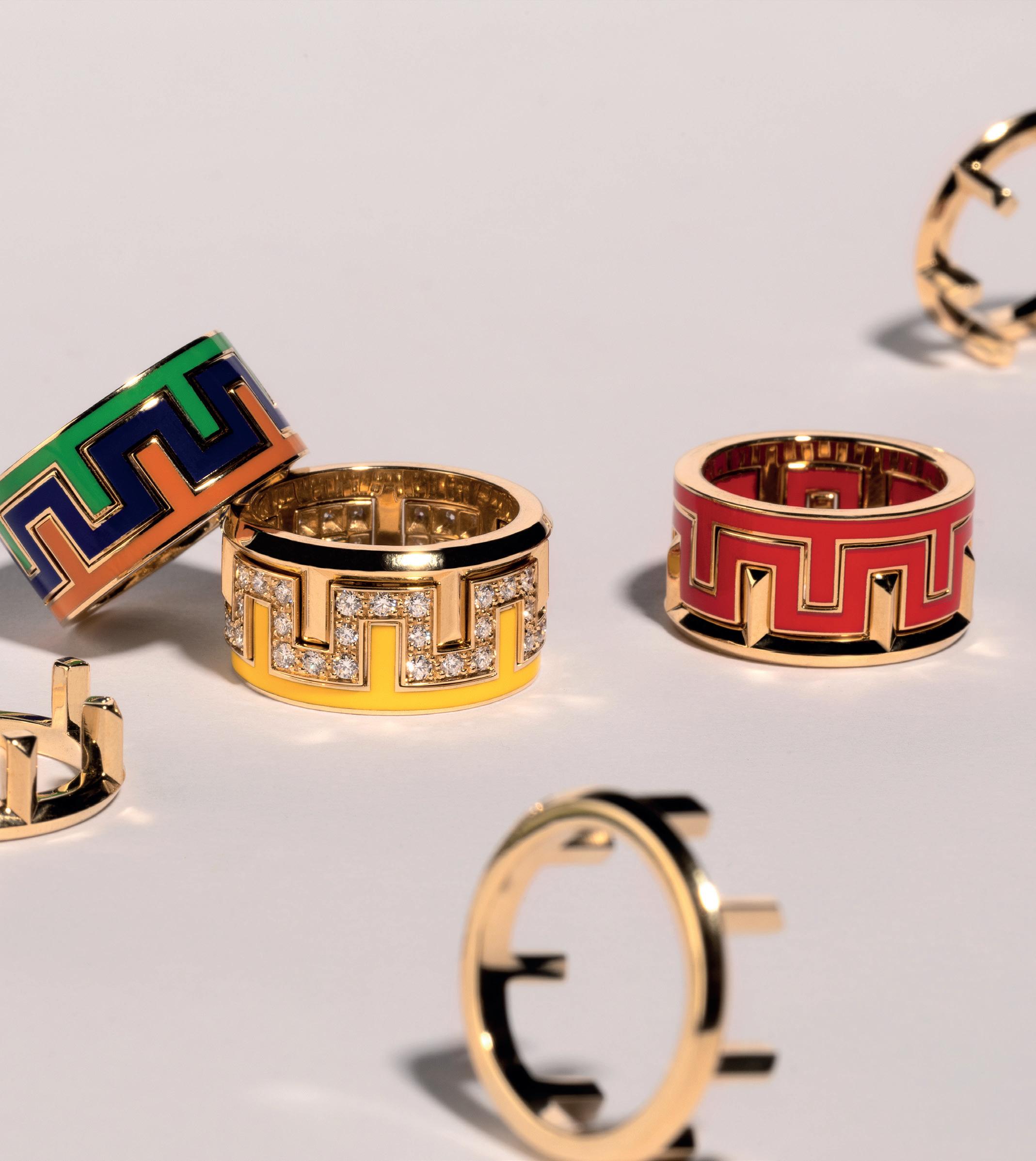
WWW.VANESSER.COM 2000 ANTWERPEN - SCHUTTERSHOFSTRAAT 32 - INFO: 03-236 31 84 3500 HASSELT - KAPELSTRAAT 17 - INFO: 011-22 32 50













































 Kutali Camp, Lower Zambezi National Park.
Kutali Camp, Lower Zambezi National Park.
























































































